材料成型及控制工程专业英语-11.CASTING
- 格式:pps
- 大小:1.09 MB
- 文档页数:78
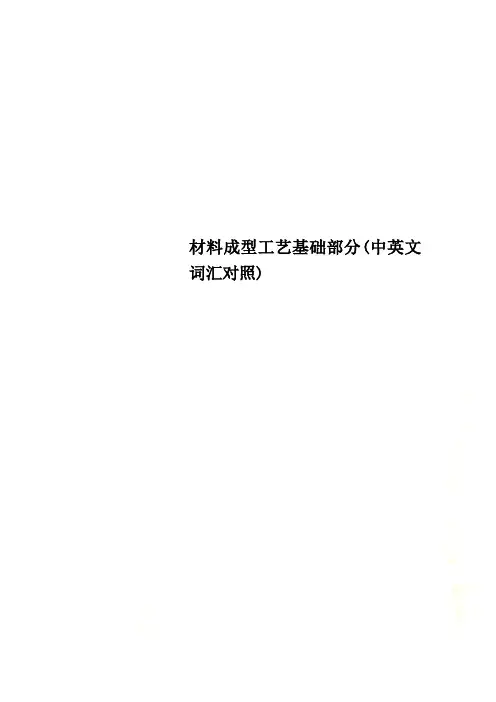
材料成型工艺基础部分(中英文词汇对照)材料成型工艺基础部分0 绪论金属材料:metal material (MR)高分子材料:high-molecular material陶瓷材料:ceramic material复合材料:composition material成形工艺:formation technology1 铸造铸造工艺:casting technique铸件:foundry goods (casting)机器零件:machine part毛坯:blank力学性能:mechanical property砂型铸造:sand casting process型砂:foundry sand1.1 铸件成形理论基础合金:alloy铸造性能:casting property工艺性能:processing property收缩性:constringency偏析性:aliquation氧化性:oxidizability吸气性:inspiratory铸件结构:casting structure使用性能:service performance浇不足:misrun冷隔:cold shut夹渣:cinder inclusion粘砂:sand fusion缺陷:flaw, defect, falling流动性:flowing power铸型:cast (foundry mold)蓄热系数:thermal storage capacity 浇注:pouring凝固:freezing收缩性:constringency逐层凝固:layer-by-layer freezing 糊状凝固:mushy freezing结晶:crystal缩孔:shrinkage void缩松:shrinkage porosity顺序凝固:progressive solidification 冷铁:iron chill补缩:feeding等温线法:constant temperature line method 内接圆法:inscribed circle method铸造应力:casting stress变形:deforming裂纹:crack机械应力:mechanical stress热应力:heat stress相变应力:transformation stress气孔:blow hole铸铁:ingot铸钢:cast steel非铁合金:nonferrous alloy灰铸铁:gray cast-iorn孕育处理:inoculation球墨铸铁:spheroidal球化处理:sheroidisation可锻铸铁:ductile cast iron石墨:graphite蠕墨铸铁:vermicular cast iron热处理:heat processing铝合金:Al-alloy熔炼:fusion metallurgy铜合金:copper alloy氢脆:hydrogen brittleness1.2 铸造方法(casting method)手工造型:hand moulding机器造型:machine moulding金属型:metal mold casting金属模:permanent mould压力铸造:press casting熔模铸造:investment moulding蜡膜:cere离心铸造:centrifugal casting低压铸造:casting under low pressure 差压铸造:counter-pressure casting 陶瓷型铸造:shaw process1.3 铸造工艺设计浇注位置:pouring position分型面:mould joint活块:loose piece起模:patter drawing型芯:core型芯撑:chaplet工艺参数:processing parameter下芯:core setting合型:mould assembly冒口:casting head尺寸公差:dimensional tolerance尺寸公差带:tolerance zone机械加工余量:machining allowance 铸孔:core hole非标准:nonstandard label收缩率:rate of contraction线收缩:linear contraction体收缩:volume contraction起模斜度:pattern draft铸造圆角:curving of castings芯头:core register芯头间隙:clearance芯座:core print seat分型线:joint line分模线:die parting line1.4 铸造结构工艺性加强筋:rib reinforcement撒砂:stuccoing内腔:entocoele2 金属塑性加工塑性加工:plastic working塑性:plastic property锻造:forge work冲压:punching轧制:rolling拉拔:drawing挤压:extruding细化晶粒:grain refinement热锻:hit-forging温锻:warm forging2.1 金属塑性加工理论基础塑性变形:plastic yield加工硬化:work-hardening韧性:ductility回复温度:return temperature 再结晶:recrystallize再结晶退火:full annealing冷变形:cold deformation热变性:heat denaturation锻造比:forging ratio镦粗:upset拔长:pull out纤维组织:fibrous tissue锻造性能:forging property可锻性:forgeability变形抗力:resistance of deformation化学成分:chemical constitution热脆性:hot brittleness冷脆性:cold-shortness变形速度:deformation velocity应力状态:stress condition变形温度:deformation temperature过热:overheating过烧:burning脱碳:carbon elimination始锻温度:initiation forging temperature 终锻温度:final forging temperature2.2 金属塑性加工方法自由锻:flat-die hammer冲孔:jetting弯曲:bend弯曲半径:bending radius切割:cut扭转:twist rotation错移:offsetting锻接:percussion基本工序:basic process辅助工序:auxiliary process精整工序:finishing process模锻:contour forging锻模:forging die胎膜锻:fetal membrane forging剪床:shearing machine冲床:backing-out punch冲裁:blanking弹性变形:elastic distortion塑性变形:plastic yield剪切变形:shearing deformation最小弯曲半径:minimum bending radius 曲率:angularity弯裂:rupture回弹:rebound辊轧:roll forming辊锻:roll forging斜轧:oblique rolling横轧:transverse rolling辗压:tamping drum挤压:extruding拉拔:draft2.3 塑性加工工艺设计工艺规程:process specification锻件图:forging drawing敷料:dressing锻件余量:forging allowance锻件公差:forging tolerance工夹具:clamping apparatus加热设备:firing equipment加热规范:heating schedule冷却规范:cooling schedule后续处理:after treatment分模面:die parting face冲孔连皮:punching the wad模锻斜度:draft angle圆角半径:radius of corner圆饼类锻件:circumcresent cake-like forging 长轴类锻件:long axis-like forging2.4 锻件结构工艺性锥体:cone斜面:cant空间曲线:curve in space粗糙度:degree of roughness2.5 冲压件结构工艺性3 焊接焊接:welding铆接:riverting熔焊:fusion welding压焊:press welding钎焊:braze welding3.1 焊接理论基础冶金:metallurgy电弧焊:arc welding气焊:acetylene welding电渣焊:electro-slag welding高能束焊:high energy welding 电子焊:electronic welding激光焊:laser welding等离子焊:plasma welding电弧:electric arc阳极区:anode region阴极区:negative polarity弧柱区:arc stream正接法:electrode negative method反接法:opposition method脱氧剂:deoxidizing agent焊缝:welded seam焊缝区:weld zone熔合区:fusion area热影响区:heat-affected zone脆性断裂:brittle fracture过热区:overheated zone正火区:normalized zone相变区:phase change zone焊接应力:welding stress收缩变形:contraction distortion角变形:angular deformation弯曲变形:bend deformation扭曲变形:warping deformation波浪变形:wave transformation反变形法:reversible deformation method 刚性固定法:rigid fixing method预热:warming-up缓冷:slow cool焊后热处理:postweld heat treatment矫形处理:shape-righting3.2 焊接方法埋弧焊:hidden arc welding气体保护焊:gas shielded arc welding氩弧焊:argon welding熔化极氩弧焊:consumable electrode argon welding 钨极氩弧焊:argon tungsten-arc welding二氧化碳气体保护焊:CO2 gas shielded arc welding 碳弧焊:carbon arc welding碳弧气刨:carbon arc air gouging电渣焊:electro-slag welding高能焊:high grade energy welding等离子弧切割:plasma arc cutting (PAC)堆焊:bead weld电阻焊:resistance welding电焊:electric welding缝焊:seam welding压焊:press welding多点凸焊:multiple projection welding对焊:welding neck摩擦焊:friction welding扩散焊:diffusion welding硬钎料:brazing alloy软钎料:soft solder3.3 常用金属材料的焊接焊接性:weldability焊接方法:welding method 焊接材料:welding material 焊条:electrode焊剂:flux material碳素钢:carbon steel低碳钢:low carbon steel中碳钢:medium carbon steel 高碳钢:high carbon steel低合金钢:lean alloy steel不锈钢:non-corrosive steel 有色金属:nonferrous metal 3.4 焊接工艺设计型材:sectional bar药皮:coating焊丝:soldering wire连续焊缝:continuous weld断续焊缝:intermittent weld应力集中:stress concentration焊接接头:soldered joint坡口:groove对接:abutting joint搭接:lap joint角接:corner joint4 粉末冶金(power metallurgy)粉末冶金成品:finished power metallurgical product 铁氧体:ferrite硬质合金:sintered-carbide高熔点金属:high-melting metal陶瓷:ceramic4.1 粉末冶金工艺理论基础压坯:pressed compact扩散:diffusion烧结:agglomeration固溶:solid solubility化合:combination4.2 粉末冶金的工艺流程制备:preparation预处理:anticipation还原法:reduction method电解法:electrolytic method雾化法:atomization粒度:grain size松装密度:loose density流动性:flowing power压缩性:compressibility筛分:screen separation混合:compounding制粒:pelletization过烧:superburning欠烧:underburnt5 金属复合成型技术自蔓延焊接:SHS welding热等静压:HIP准热等静压:PHIP5.1 液态成型技术与固态成型技术的复合高压铸造:high-pressure casting电磁泵:magnetic-pump压射成型:injection molding柱塞:plunger piston冲头:drift pin凝固法:freezing method挤压法:extrusion method转向节:knuckle pivot制动器:arresting gear5.2 金属半凝固、半熔融成型技术凝固:freezing半熔融:semi-vitreous触变铸造:thixotropy casting触变锻造:thixotropy forging注射成型:injection molding5.3 其他金属成型新技术快速凝固:flash set非晶态:amorphous溢流法:press over system喷射沉积:ejecting deposit爆炸复合法:explosion cladding method 扩散焊接:diffusion welding挤压:extruding轧制:roll down6 非金属材料成型技术6.1 高分子材料成型技术高分子材料:non-metal material耐腐蚀:resistant material绝缘:insulation老化:ageing耐热性:heat-durability粘弹性:viscoelasticity塑料:plastic material橡胶:rubber合成纤维:synthetic fibre涂料:covering material粘结剂:agglomerant粘度:viscosity热塑性塑料:thermoplastic plastics 热固性塑料:thermosetting plastic 通用塑料:general-purpose plastics 工程塑料:engineering plastic薄膜:thin film增强塑料:reinforced plastics浇注塑料:pouring plastics注射塑料:injiection plastics挤出塑料:extrusion plastics吹塑塑料:blowing plastics模压塑料:die pressing plastics聚合物:ploymer semiconductor吸湿性:hygroscopic cargo定向作用:directional action生胶:green glue stock填料:carrier丁苯橡胶:SBR顺丁橡胶:BR氯丁橡胶:CR丁腈橡胶:NBR硅橡胶:Q聚氨酯橡胶:U压延:calender硫化:sulfuration胶粘剂:adhesive胶接:glue joint刹车片:brake block零件修复:parts renewal蜂窝夹层:honeycomb core material 6.2 工业陶瓷制品的成型技术干燥:drying坯料:blank润滑剂:anti-friction结合剂:binder热压铸:hot injiection moulding 6.3 非金属材料成型技术的新进展热压烧结:hot pressed sintering7 复合材料的成型技术复合材料:composite material树脂:resin7.1 金属复合材料的成型技术硼纤维:boron fiber钛合金:titanium alloy碳纤维:carbon filter等离子喷涂:plasma spraying浸渍法:immersion method锭坯:ingot blank7.2 聚合物基复合材料的成型技术晶须:whisker缠绕成形:enwind forming湿法缠绕:wet method enwind 7.3 陶瓷复合材料成型技术料浆:slurry溶胶-凝胶法:sol-gel method化学气相沉积:chemical vapor deposition (CVD) 原位:in situ8 材料成型方法的选择粉末冶金:powder metallurgy工程塑料:engineering plastics工程陶瓷:engineering ceramics。
![材料成型及控制工程专业英语词汇表[借鉴]](https://uimg.taocdn.com/2414d376dcccda38376baf1ffc4ffe473368fd1f.webp)
Unit One arbitrary:任意的,武断的,专制的invariably:不变的,一定的sharply:剧烈的electrical power:电源blast furnace:高炉coke:焦炭Iron ore:铁矿石limestone:石灰石reduction:还原反应slag:炉渣tap:阀门,出渣口Property:Load support:pig iron:生铁cupola:化铁炉ladle:钢水包Fule:燃料Flux:溶剂mold:模具tension:拉力intricate:复杂的negligible:微不足道的wrought iron:锻铁,熟铁Free graphite:自由石墨flack graphite:片状的石墨mild steel:低碳钢ferrous alloy:铁合金moderately priced:价格适中ductile:延展Elastic:弹性durable:耐用的non-ferrous:eminently practical:非常实用ball bearings:滚珠轴承metal sheet:金属板AISI:code designation:规定牌号plain steel:碳素钢approximate:近似的high strength low alloy steel:高强度低合金钢proprietary:专卖的specified:规定的,详细说明的optimal:最佳的,最理想的hot rolling:热轧elevated:提高的stress relief:应力消除justification:理由,superalloy:超耐热高应力耐蚀合金rust:生锈chromium:铬austenite:奥氏体nickel:镍ferritic stainless steel:铁素体不锈钢serviceable:可以使用的quench:淬火body centered tetragonal crystal structure:体心四方晶体结构yield high strength:产生高强度cutlery:刀具,餐具spring:弹簧precipitation hardening:沉淀硬化essentially:本质上dislocation motion:位错运动corrosion resistance structural members:耐腐蚀结构件tungsten:钨molybdenum:钼chromium:铬dual:双重的heat resistance:耐热的cobalt:钴oxidation:氧化justifying:证明,,,有理severe:严峻的carbide formation kinetics:碳化物形成动力学viscosities:粘性surface flim:表面膜shrinkage:收缩solidifacation:凝固inferior:差的uniform:统一的,均衡的porosity:有孔的forge:锻造simple shape:简单断面型钢white iron:白口铸铁crystalline fracture surface:结晶断面gray iron:灰口铸铁significant:有效的,有意义的precipitation:沉淀flakes:片状的magnesium:镁spheroidal:球状的ductile iron:球墨铸铁by a factor of 20:是原来的20倍malleable iron:可锻铸铁nodular graphite:球形石墨equivalent:等价的Welding:焊接Consult:查阅Scientific literature:科学文献Symbol:符号Topic:话题Corresponding author:通讯作者Keywords:关键词Abstract:摘要Classification number:中图分类号Reference:参考文献Retrieval word:检索词Background:研究背景Correlation:相关性,关联Unit threeLesson one Manufacturing:v.生存、制造;n.制造业;Shapeless:不成型的、不定型的;Accuracy:精度;Tolerance:公差;Classification:类别;Assemble:装配;Metallurgy:A simplifide manner:简化的方式;Melt extrusion:熔融挤出;Die casting:模具铸造,压力铸造、拉模铸造;Pressing of metal powder:金属粉末压制;Rolling:轧制;Extrusion:挤压;Formulation:Cold and hot forging:冷锻/自由锻和热锻;Deep drawing:拉深(深冲压);Sawing:锯切;Plastic deformation:Turning:车削;Milling:铣削;Broaching:拉削、绞孔、扩孔;Removing metal:Blacksmith:铁匠;Locksmith:Grind/graind:磨;Metal treatment processes:金属处理工艺;Heat treating:Anodizing:阳极氧化处理;Surface hardening:表面硬化;Essentially:本质上;Joining processes:连接;Metallurgical joining:冶金连接;Welding:焊接;Diffusion bonding:扩散接合;Riveting:铆接;Mechanical:Shrink fitting:预紧(过盈)装配;Production rates:生产率;Capable:有能力的;Recrystallization temperature:Extraordinary cost:额外成本;Die set:模座;Varible:可变因素,变量;Dimensional:空间的,尺寸的;Specified:规定的,详细说明的;Dimensional tolerance:尺寸公差;Surface finish:表面光洁度;Quality:质量;Sophisticated:复杂的;Variation:变化;Means of new development:新开发的手段;Lost wax vacuum casting:失蜡真空铸造;Tighter tolerance:更严格的公差;Brake drum:刹车鼓;Vibration:震动;Interchangeability:可替换性;Defective:有缺陷的;Modern mass production:现代大规模生产;Indicate:表明,指出;Gross national product:国民生产总值;Manufacturing industries:制造业;Manufacturing productivity:制造业的生存率;Discrete parts:分立零件;Ingredient:原料,要素,组成部分;Human and managerial resource:人力及管理资源;Plant:工厂,车间;Interface:相互作用;Physiological:生理学的;Psychological:心理学的;Precede:领先,在。

材料成型及控制工程专业英语Mechanical property机械性能austenitic奥氏体的martensite 马氏体Plastic deformation塑性变形stress concentrator应力集中点bar棒材beam线材sheet板材ductile可延展的stress relief应力松弛austenitie奥氏体 martensite马氏体normalize正火temper回火anneal正火harden淬火close-die forging模锻deformation rate变形速度diffusion扩散overheat过热Work hardening加工硬化dislocation density位错密度die模具residual strain残留应变as-forged锻造的injection mold注射模molding shop成型车间clamping force合模力grind磨削drop stamping锤上模锻nickel-base superalloy镍基合金insulation 隔热burr毛刺injection capacity注射容量deterioration变化、退化discrete不连续的abrasive磨损welding焊接metallurgical 冶金的Formation of austenite奥氏体转变The transformation of pearlite(珠光体)into austenite can only take place at the equilibrium critical point(临界温度)a very slow heating as follows from the Fe-C constitutional diagram(状态图). under common conditions, the transformation is retarded and results in overheating,i.e.occurs at temperatures slightly higher than those indicated in the Fe-C diagram.The end of the transformation iS characterized by the formation of austenite and the dis—appearance of pearlite(ferrite+cementite).This austenite is however inhomogeneous even in the volume of a single grain.In places earlier occupied by lamellae(层片)(or grains)of a pearlitic cementite,the content of carbon is greater than in places of ferritic lamellae.This is why the austenite just formed is inhomogeneous.In order to obtain homogeneous (均匀的)austenite,it is essential on heating not only to pass through the point of the end of pearlite to austenite transformation,but also to overheat the steel above that point and to allow a holding time to complete the diffusion(扩散) processes in aus-tenitie grains.为了获得均匀的奥氏体,在加热过程中通过珠光体的结束点向奥氏体转变是必要的,而且对过热刚以上的点,允许持续一定时间来完成奥氏体晶粒的扩撒过程。
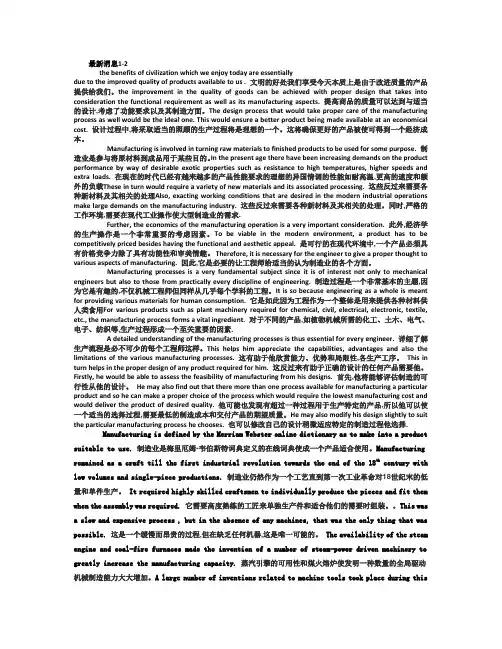
最新消息1-2the benefits of civilization which we enjoy today are essentiallydue to the improved quality of products available to us .文明的好处我们享受今天本质上是由于改进质量的产品提供给我们。
the improvement in the quality of goods can be achieved with proper design that takes into consideration the functional requirement as well as its manufacturing aspects. 提高商品的质量可以达到与适当的设计,考虑了功能要求以及其制造方面。
The design process that would take proper care of the manufacturing process as well would be the ideal one. This would ensure a better product being made available at an economical cost.设计过程中,将采取适当的照顾的生产过程将是理想的一个。
这将确保更好的产品被使可得到一个经济成本。
Manufacturing is involved in turning raw materials to finished products to be used for some purpose. 制造业是参与将原材料到成品用于某些目的。
In the present age there have been increasing demands on the product performance by way of desirable exotic properties such as resistance to high temperatures, higher speeds and extra loads.在现在的时代已经有越来越多的产品性能要求的理想的异国情调的性能如耐高温,更高的速度和额外的负载These in turn would require a variety of new materials and its associated processing.这些反过来需要各种新材料及其相关的处理Also, exacting working conditions that are desired in the modern industrial operations make large demands on the manufacturing industry.这些反过来需要各种新材料及其相关的处理。
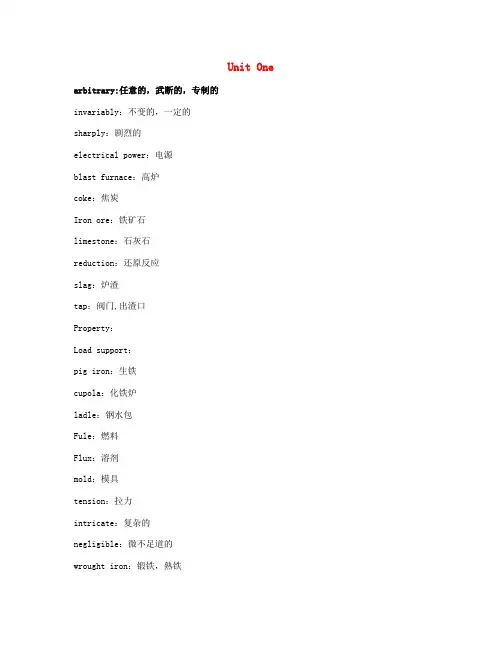
Unit One arbitrary:任意的,武断的,专制的invariably:不变的,一定的sharply:剧烈的electrical power:电源blast furnace:高炉coke:焦炭Iron ore:铁矿石limestone:石灰石reduction:还原反应slag:炉渣tap:阀门,出渣口Property:Load support:pig iron:生铁cupola:化铁炉ladle:钢水包Fule:燃料Flux:溶剂mold:模具tension:拉力intricate:复杂的negligible:微不足道的wrought iron:锻铁,熟铁Free graphite:自由石墨flack graphite:片状的石墨mild steel:低碳钢ferrous alloy:铁合金moderately priced:价格适中ductile:延展Elastic:弹性durable:耐用的non-ferrous:eminently practical:非常实用ball bearings:滚珠轴承metal sheet:金属板AISI:code designation:规定牌号plain steel:碳素钢approximate:近似的high strength low alloy steel:高强度低合金钢proprietary:专卖的specified:规定的,详细说明的optimal:最佳的,最理想的hot rolling:热轧elevated:提高的stress relief:应力消除justification:理由,superalloy:超耐热高应力耐蚀合金turbine blade:涡轮叶片rust:生锈chromium:铬austenite:奥氏体nickel:镍ferritic stainless steel:铁素体不锈钢serviceable:可以使用的quench:淬火body centered tetragonal crystal structure:体心四方晶体结构yield high strength:产生高强度cutlery:刀具,餐具spring:弹簧precipitation hardening:沉淀硬化essentially:本质上dislocation motion:位错运动corrosion resistance structural members:耐腐蚀结构件tungsten:钨molybdenum:钼chromium:铬dual:双重的heat resistance:耐热的cobalt:钴oxidation:氧化justifying:证明,,,有理severe:严峻的turbojet:涡轮喷气飞机carbide formation kinetics:碳化物形成动力学viscosities:粘性surface flim:表面膜shrinkage:收缩solidifacation:凝固inferior:差的uniform:统一的,均衡的porosity:有孔的forge:锻造simple shape:简单断面型钢white iron:白口铸铁crystalline fracture surface:结晶断面gray iron:灰口铸铁significant:有效的,有意义的precipitation:沉淀flakes:片状的magnesium:镁spheroidal:球状的ductile iron:球墨铸铁by a factor of 20:是原来的20倍malleable iron:可锻铸铁nodular graphite:球形石墨equivalent:等价的Welding:焊接Consult:查阅Scientific literature:科学文献Symbol:符号Topic:话题Corresponding author:通讯作者Keywords:关键词Abstract:摘要Classification number:中图分类号Reference:参考文献Retrieval word:检索词Background:研究背景Correlation:相关性,关联Unit threeLesson one Manufacturing:v.生存、制造;n.制造业;Shapeless:不成型的、不定型的;Accuracy:精度;Tolerance:公差;Classification:类别;Assemble:装配;Metallurgy:A simplifide manner:简化的方式;Melt extrusion:熔融挤出;Die casting:模具铸造,压力铸造、拉模铸造;Pressing of metal powder:金属粉末压制;Rolling:轧制;Extrusion:挤压;Formulation:Cold and hot forging:冷锻/自由锻和热锻;Deep drawing:拉深(深冲压);Sawing:锯切;Plastic deformation:Turning:车削;Milling:铣削;Broaching:拉削、绞孔、扩孔;Removing metal:Blacksmith:铁匠;Locksmith:Grind/graind:磨;Metal treatment processes:金属处理工艺;Heat treating:Anodizing:阳极氧化处理;Surface hardening:表面硬化;Essentially:本质上;Joining processes:连接;Metallurgical joining:冶金连接;Welding:焊接;Diffusion bonding:扩散接合;Riveting:铆接;Mechanical:Shrink fitting:预紧(过盈)装配;Production rates:生产率;Capable:有能力的;Recrystallization temperature:Extraordinary cost:额外成本;Die set:模座;Varible:可变因素,变量;Dimensional:空间的,尺寸的;Specified:规定的,详细说明的;Dimensional tolerance:尺寸公差;Surface finish:表面光洁度;Quality:质量;Sophisticated:复杂的;Variation:变化;Means of new development:新开发的手段;Lost wax vacuum casting:失蜡真空铸造;Tighter tolerance:更严格的公差;Brake drum:刹车鼓;Vibration:震动;Interchangeability:可替换性;Defective:有缺陷的;Modern mass production:现代大规模生产;Indicate:表明,指出;Gross national product:国民生产总值;Manufacturing industries:制造业;Manufacturing productivity:制造业的生存率;Discrete parts:分立零件;Ingredient:原料,要素,组成部分;Human and managerial resource:人力及管理资源;Plant:工厂,车间;Interface:相互作用;Physiological:生理学的;Psychological:心理学的;Precede:领先,在。
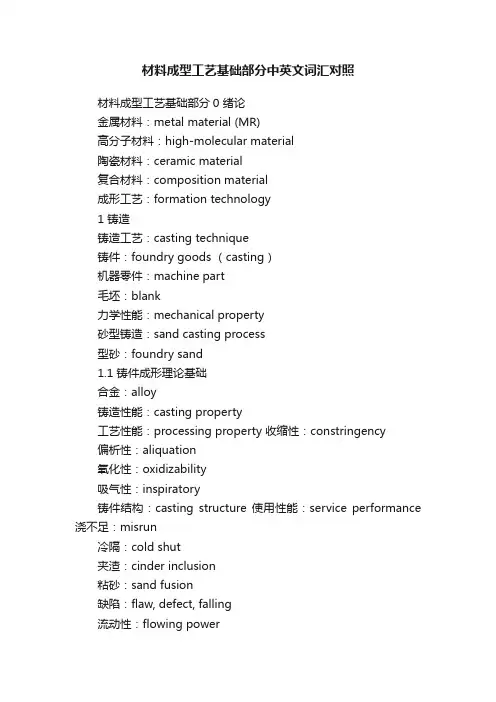
材料成型工艺基础部分中英文词汇对照材料成型工艺基础部分0 绪论金属材料:metal material (MR)高分子材料:high-molecular material陶瓷材料:ceramic material复合材料:composition material成形工艺:formation technology1 铸造铸造工艺:casting technique铸件:foundry goods (casting)机器零件:machine part毛坯:blank力学性能:mechanical property砂型铸造:sand casting process型砂:foundry sand1.1 铸件成形理论基础合金:alloy铸造性能:casting property工艺性能:processing property 收缩性:constringency偏析性:aliquation氧化性:oxidizability吸气性:inspiratory铸件结构:casting structure 使用性能:service performance 浇不足:misrun冷隔:cold shut夹渣:cinder inclusion粘砂:sand fusion缺陷:flaw, defect, falling流动性:flowing power铸型:cast (foundry mold)蓄热系数:thermal storage capacity浇注:pouring凝固:freezing收缩性:constringency逐层凝固:layer-by-layer freezing糊状凝固:mushy freezing结晶:crystal缩孔:shrinkage void缩松:shrinkage porosity顺序凝固:progressive solidification冷铁:iron chill补缩:feeding等温线法:constant temperature line method内接圆法:inscribed circle method 铸造应力:casting stress 变形:deforming裂纹:crack机械应力:mechanical stress热应力:heat stress相变应力:transformation stress 气孔:blow hole铸铁:ingot铸钢:cast steel非铁合金:nonferrous alloy灰铸铁:gray cast-iorn孕育处理:inoculation球墨铸铁:spheroidal球化处理:sheroidisation可锻铸铁:ductile cast iron石墨:graphite蠕墨铸铁:vermicular cast iron 热处理:heat processing铝合金:Al-alloy熔炼:fusion metallurgy铜合金:copper alloy氢脆:hydrogen brittleness1.2 铸造方法(casting method)手工造型:hand moulding机器造型:machine moulding金属型:metal mold casting金属模:permanent mould压力铸造:press casting熔模铸造:investment moulding蜡膜:cere离心铸造:centrifugal casting低压铸造:casting under low pressure 差压铸造:counter-pressure casting 陶瓷型铸造:shaw process1.3 铸造工艺设计浇注位置:pouring position分型面:mould joint活块:loose piece起模:patter drawing型芯:core型芯撑:chaplet工艺参数:processing parameter下芯:core setting合型:mould assembly冒口:casting head尺寸公差:dimensional tolerance 尺寸公差带:tolerance zone 机械加工余量:machining allowance 铸孔:core hole非标准:nonstandard label收缩率:rate of contraction线收缩:linear contraction体收缩:volume contraction起模斜度:pattern draft铸造圆角:curving of castings芯头:core register芯头间隙:clearance芯座:core print seat分型线:joint line分模线:die parting line 1.4 铸造结构工艺性加强筋:rib reinforcement 撒砂:stuccoing内腔:entocoele2 金属塑性加工塑性加工:plastic working 塑性:plastic property锻造:forge work冲压:punching轧制:rolling拉拔:drawing挤压:extruding细化晶粒:grain refinement 热锻:hit-forging2.1 金属塑性加工理论基础塑性变形:plastic yield加工硬化:work-hardening韧性:ductility回复温度:return temperature 再结晶:recrystallize 再结晶退火:full annealing 冷变形:cold deformation 热变性:heat denaturation锻造比:forging ratio镦粗:upset拔长:pull out纤维组织:fibrous tissue锻造性能:forging property变形抗力:resistance of deformation化学成分:chemical constitution热脆性:hot brittleness冷脆性:cold-shortness变形速度:deformation velocity应力状态:stress condition变形温度:deformation temperature过热:overheating过烧:burning脱碳:carbon elimination始锻温度:initiation forging temperature 终锻温度:final forging temperature2.2 金属塑性加工方法自由锻:flat-die hammer弯曲:bend弯曲半径:bending radius切割:cut扭转:twist rotation错移:offsetting锻接:percussion基本工序:basic process辅助工序:auxiliary process精整工序:finishing process模锻:contour forging锻模:forging die胎膜锻:fetal membrane forging 剪床:shearing machine冲床:backing-out punch弹性变形:elastic distortion塑性变形:plastic yield剪切变形:shearing deformation最小弯曲半径:minimum bending radius 曲率:angularity弯裂:rupture回弹:rebound辊轧:roll forming辊锻:roll forging斜轧:oblique rolling横轧:transverse rolling辗压:tamping drum挤压:extruding拉拔:draft2.3 塑性加工工艺设计工艺规程:process specification 锻件图:forging drawing敷料:dressing锻件余量:forging allowance锻件公差:forging tolerance工夹具:clamping apparatus加热设备:firing equipment加热规范:heating schedule冷却规范:cooling schedule后续处理:after treatment分模面:die parting face冲孔连皮:punching the wad模锻斜度:draft angle圆角半径:radius of corner圆饼类锻件:circumcresent cake-like forging 长轴类锻件:long axis-like forging2.4 锻件结构工艺性锥体:cone斜面:cant空间曲线:curve in space粗糙度:degree of roughness2.5 冲压件结构工艺性3 焊接焊接:welding铆接:riverting熔焊:fusion welding压焊:press welding钎焊:braze welding3.1 焊接理论基础冶金:metallurgy电弧焊:arc welding气焊:acetylene welding电渣焊:electro-slag welding高能束焊:high energy welding电子焊:electronic welding激光焊:laser welding等离子焊:plasma welding电弧:electric arc阳极区:anode region阴极区:negative polarity弧柱区:arc stream正接法:electrode negative method 反接法:opposition method脱氧剂:deoxidizing agent焊缝:welded seam焊缝区:weld zone熔合区:fusion area热影响区:heat-affected zone脆性断裂:brittle fracture过热区:overheated zone正火区:normalized zone相变区:phase change zone焊接应力:welding stress收缩变形:contraction distortion角变形:angular deformation弯曲变形:bend deformation扭曲变形:warping deformation波浪变形:wave transformation反变形法:reversible deformation method刚性固定法:rigid fixing method预热:warming-up缓冷:slow cool焊后热处理:postweld heat treatment矫形处理:shape-righting3.2 焊接方法埋弧焊:hidden arc welding气体保护焊:gas shielded arc welding氩弧焊:argon welding熔化极氩弧焊:consumable electrode argon welding 钨极氩弧焊:argon tungsten-arc weldinggas shielded arc welding 二氧化碳气体保护焊:CO2碳弧焊:carbon arc welding碳弧气刨:carbon arc air gouging电渣焊:electro-slag welding高能焊:high grade energy welding等离子弧切割:plasma arc cutting (PAC)堆焊:bead weld电阻焊:resistance welding电焊:electric welding缝焊:seam welding压焊:press welding多点凸焊:multiple projection welding 对焊:welding neck 摩擦焊:friction welding扩散焊:diffusion welding硬钎料:brazing alloy软钎料:soft solder3.3 常用金属材料的焊接焊接性:weldability焊接方法:welding method焊接材料:welding material 焊条:electrode焊剂:flux material碳素钢:carbon steel低碳钢:low carbon steel中碳钢:medium carbon steel 高碳钢:high carbon steel 低合金钢:lean alloy steel 不锈钢:non-corrosive steel 有色金属:nonferrous metal 3.4 焊接工艺设计型材:sectional bar药皮:coating焊丝:soldering wire。
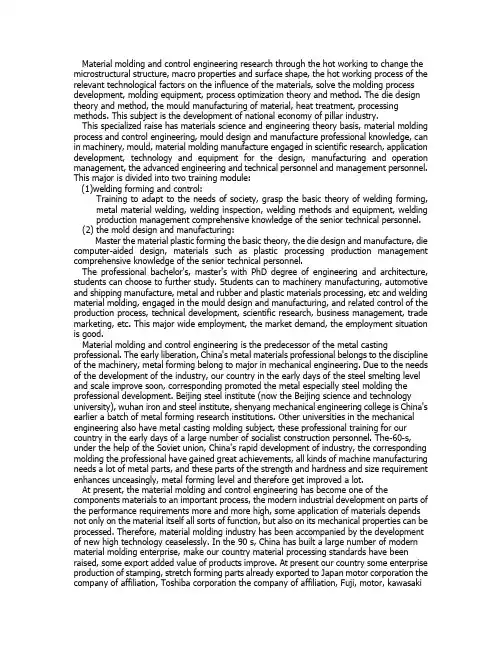
Material molding and control engineering research through the hot working to change the microstructural structure, macro properties and surface shape, the hot working process of the relevant technological factors on the influence of the materials, solve the molding process development, molding equipment, process optimization theory and method. The die design theory and method, the mould manufacturing of material, heat treatment, processing methods. This subject is the development of national economy of pillar industry.This specialized raise has materials science and engineering theory basis, material molding process and control engineering, mould design and manufacture professional knowledge, can in machinery, mould, material molding manufacture engaged in scientific research, application development, technology and equipment for the design, manufacturing and operation management, the advanced engineering and technical personnel and management personnel. This major is divided into two training module:(1)welding forming and control:Training to adapt to the needs of society, grasp the basic theory of welding forming, metal material welding, welding inspection, welding methods and equipment, welding production management comprehensive knowledge of the senior technical personnel.(2) the mold design and manufacturing:Master the material plastic forming the basic theory, the die design and manufacture, die computer-aided design, materials such as plastic processing production management comprehensive knowledge of the senior technical personnel.The professional bachelor's, master's with PhD degree of engineering and architecture, students can choose to further study. Students can to machinery manufacturing, automotive and shipping manufacture, metal and rubber and plastic materials processing, etc and welding material molding, engaged in the mould design and manufacturing, and related control of the production process, technical development, scientific research, business management, trade marketing, etc. This major wide employment, the market demand, the employment situation is good.Material molding and control engineering is the predecessor of the metal casting professional. The early liberation, China's metal materials professional belongs to the discipline of the machinery, metal forming belong to major in mechanical engineering. Due to the needs of the development of the industry, our country in the early days of the steel smelting level and scale improve soon, corresponding promoted the metal especially steel molding the professional development. Beijing steel institute (now the Beijing science and technology university), wuhan iron and steel institute, shenyang mechanical engineering college is China's earlier a batch of metal forming research institutions. Other universities in the mechanical engineering also have metal casting molding subject, these professional training for our country in the early days of a large number of socialist construction personnel. The-60-s, under the help of the Soviet union, China's rapid development of industry, the corresponding molding the professional have gained great achievements, all kinds of machine manufacturing needs a lot of metal parts, and these parts of the strength and hardness and size requirement enhances unceasingly, metal forming level and therefore get improved a lot.At present, the material molding and control engineering has become one of the components materials to an important process, the modern industrial development on parts of the performance requirements more and more high, some application of materials depends not only on the material itself all sorts of function, but also on its mechanical properties can be processed. Therefore, material molding industry has been accompanied by the development of new high technology ceaselessly. In the 90 s, China has built a large number of modern material molding enterprise, make our country material processing standards have been raised, some export added value of products improve. At present our country some enterprise production of stamping, stretch forming parts already exported to Japan motor corporation the company of affiliation, Toshiba corporation the company of affiliation, Fuji, motor, kawasakiheavy industries, wu mountain instrument corporation and other enterprise. By cold forming, hot extrusion process of copper pipe production has been exported to the United States, Germany and Australia and other countries.Our country material molding and control technology is still needs further development, computer control forming technology in our country at present is still in the initial stage, and in this industry the technology level of our country in the world still is backward, and our country to this domain product demand is big rise, thereby material molding field would be in the next few years for considerable development. 21 century information industry, material industry, the energy industry will be the national production of the three pillar industries, and material molding and control technology material industry is one of the important parts, it would involve all fields of national production.。
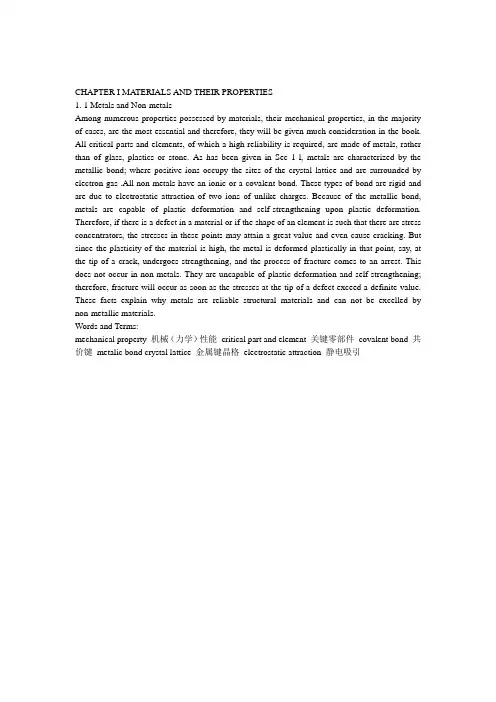
CHAPTER I MA TERIALS AND THEIR PROPERTIES1. 1 Metals and Non-metalsAmong numerous properties possessed by materials, their mechanical properties, in the majority of cases, are the most essential and therefore, they will be given much consideration in the book. All critical parts and elements, of which a high reliability is required, are made of metals, rather than of glass, plastics or stone. As has been given in Sec 1-l, metals are characterized by the metallic bond; where positive ions occupy the sites of the crystal lattice and are surrounded by electron gas .All non-metals have an ionic or a covalent bond. These types of bond are rigid and are due to electrostatic attraction of two ions of unlike charges. Because of the metallic bond, metals are capable of plastic deformation and self-strengthening upon plastic deformation. Therefore, if there is a defect in a material or if the shape of an element is such that there are stress concentrators, the stresses in these points may attain a great value and even cause cracking. But since the plasticity of the material is high, the metal is deformed plastically in that point, say, at the tip of a crack, undergoes strengthening, and the process of fracture comes to an arrest. This does not occur in non-metals. They are uncapable of plastic deformation and self-strengthening; therefore, fracture will occur as soon as the stresses at the tip of a defect exceed a definite value. These facts explain why metals are reliable structural materials and can not be excelled by non-metallic materials.Words and Terms:mechanical property 机械(力学)性能critical part and element 关键零部件covalent bond 共价键metalic bond crystal lattice 金属键晶格electrostatic attraction 静电吸引plastic deformation 塑性变形self-strengthening 自强化stress oncentrator 应力集中点the tip of a crack 裂纹尖端Questions: 1) What are the differences in properties between metals and non-metals?2) Why are metals capable of plastic deformation and self-strengthening?1. 2 Ferrous AlloysMore than 90 % by weight of the metallic materials used by human beings are ferrous alloys. This represents an immense family of engineering materials with a wide range of microstructures and related properties. The majority of engineering designs that require structural load support or power transmission involve ferrous alloys. As a practical matter, these alloys fall into two broad categories based on the carbon in the alloy composition. Steel generally contains between 0. 05 and 2.0 wt % carbon. The cast irons generally contain between 2.0 and 4.5 wt % carbon. Within the steel category,we shall distinguish whether or not a significant amount of alloying elements other than carbon is used . A composition of 5 wt % total non-carbon additions will serve as an arbitrary boundary between low alloy and high alloy steels. These alloy additions are chosen carefully because they invariably bring with them sharply increased materials costs. They are justified only by essential improvements in properties such as higher strength or improved corrosion resistance.Words and Terms:ferrous 铁的;含铁的corrosion resistance 耐腐蚀;抗蚀力arbitrary 特定的;武断的Questions:l) What is the difference in composition between steel and cast iron?2) How can you distinguish low alloy steels from high alloy steels?CHAPTER 2 HEA T TREA TMENT OF STEEL2. 1 Principle of Heat Treatment of SteelThe role of heat treatment in modern mechanical engineering cannot be overestimated. The changes in the properties of metals due to heat treatment are of extremely great significance.2. 1. 1 Temperature and TimeThe purpose of any heat treating process is to produce the desired changes in the structure of metal by heating to a specified temperature and by subsequent cooling.Therefore , the main factors acting in heat treatment are temperature and time , so that any processof heat treatment can be represented in temperature-time ( t-τ) coordinates .Heat treatment conditions are characterized by the following parameters: heating temperature t , i.e. the maximum temperature to which an alloy metal is heated; time of holding at the maxheating temperatureτh; heating rate νh and cooling rateνc.If heating (or cooling) is made at a constant rate, the temperature-time relationship will be described by a straight line with a respective angle of incline.With a varing heating (or cooling) rate , the actual rate should be attributed to the given temperature , more strictly , to an infinite change of temperature and time : that is the first derivative of temperature in time : νact = dt/dτ.Heat treatment may be a complex process , including multiple heating stages , interrupted or stepwise heating (cooling) , cooling to subzero temperatures , etc . Any process of heat treatment can be described by a diagram in temperature-time coordinates.Words and Terms:coordinates 坐标系heating rate 加热速度straight line 直线heating temperature 加热温度cooling rate 冷却速度first derivative 一阶导数Questions:1) What are the two main factors acting in heat treatment?2) How many stages may usually be inc luded in the heat treatment of steel?2. 1. 2 Formation of AusteniteThe transformation of pearlite into austenite can only take place at the equilibrium critical point on a very slow heating as follows from the Fe-C constitutional diagram. Under common conditions, the transformation is retarded and results in overheating, i.e. occurs at temperatures slightly higher than those indicated in the Fe-C diagram.When overheated above the critical point, pearlite transforms into austenite, the rate of transformation being dependent on the degree of overheating.The time of transformation at various temperatures (depending on the degree of overheating) shows that the transformation takes place faster (in a shorter time) at a higher temperature and occurs at a higher temperature on a quicker heating. For instance , on quick heating and holding at 780 ℃,the pearlite to austenite transformation is completed in 2 minutes and on holding at 740 ℃,in 8 minutes .The end of the transformation is characterized by the formation of austenite and the disappearance of pearlite (ferrite + cementite). This austenite is however inhomogeneous even in the volume of a single grain. In places earlier occupied by lamellae (or grains) of a pearlitic cementite , the content of carbon is greater than in places of ferritic lamellae . This is why the austenite just formed is inhomogeneous .In order to obtain homogeneous austenite , it is essential on heating not only to pass through the point of the end of pearlite to austenite transformation , but also to overheat the steel above that point and to allow a holding time to complete the diffusion processes in austenitc grains.The rate of homogenization of austenite appreciably depends on the original structure of the steel, in particular on the dispersion and particle shape of cementite. The transformations described occur more quickly when cementite particles are fine and, c therefore, have a large total surface area.Words and Terms : pearlite 珠光体constitutional diagrm 状态图inhomogeneous 不均匀的lamellae 层片critical point 临界温度overheat 过热grain 晶粒diffuse扩散Questions:1) Is there no diffusion process in the transformation from pearlite to austenite?2) Is it true that the higher the temperature, the faster the transformation from pearlite into austenite?3) How to obtain homogeneous austenite?CHAPTER 3 PRINCIPLES OF PLASTIC FORMING3. 1 Physical Metallurgy of Hot WorkingThe principles of the physical metallurgy of hot working are now well recognized. During the deformation process itself, e.g. a rolling pass, work hardening takes place but is balanced by the dynamic softening processes of recovery and recrystallization. These processes, which are thermally activated, lead to a flow stress that depends on strain rate and temperature as well as on strain. The structural changes taking place within the material result in an increase in dislocation density with strain until in austenitic steels and nickel- and copper-base alloys a critical strain (εc)is reached when the stored energy is sufficiently high to cause dynamic recrystallization . With further strain, dynamic recrystallization takes place repeatedly as the new recrystallized grains are themselves work-hardened to the critical level of stored energy. These dynamic structural changes leave the metal in an unstable state and provide the driving force for static recovery and static recrystallization to take place after the deformation pass. Static recrystallization may be followed by grain growth if the temperature is sufficiently high. In order to be able to apply these principles to commercial working processes, we require answers to two main questions: (a) how long does recrystallization take place after a deformation pass; and (b) what grain size is produced by recrystallization and grain growth? The answers determine the structure of the material entering the next and subsequent passes and hence influence the flow stress of the material and the working forces required. Eventually they determine the structure and properties of the hot worked products.Words and Terms : physical metallurgy 物理冶金work hardening 加工硬化static recovery静态回复thermally activated 热激活的hot working 热加工dynamic softening 动态软化recrystallization 再结晶dislocation density 位错密度critical strain 临界应变Questions:l) When does dynamic recrystallization take place within the material work hardened?2) What do the answers to the two questions determine?3. 1. 1 Dynamic Structural ChangeDuring the deformation of austenite at hot-working temperatures and constant strain rate, the characteristic form of stress-strain curve observed is illustrated in Fig. 3. 1. These curves are for low-alloy steels, tested in torsion, but are similar to those obtained for other steels in the austenitic condition tested in torsion, tension, or compression. After initial rapid work- hardening the curves go through a maximum associated with the occurrence of dynamic recrystallization. The peak in flow stress occurs after some low fraction of recrystallization has taken place so the strain to the peak(εp) is always greater than the critical strain for dynamic recystallization (εc ) . The relationship between the two strains is complex , but it has been suggested thatεc=αεp( where αis a constant ) is a reasonable approximation for conditions of deformation of interest in hot working. however , the proposed values of αdiffer , being 0.83 , 0.86 , and 0.67 . It can be seen from Fig.3.1 that εp increases systematically with Zener-Hollomon parameter ( Z ) , independent of the particular combination of stain rate (ε)and temperature ( T / K ) in the relationship : Z=εexp Q def/RTWhere the activation energy Q def for this alloy steel is 314 kJ/mol. A similar value of 312kJ/mol is appropriate for a range of C-Mn steels but lower values of 270 and 286 kJ/mol have also been observed.Asεc marks a change in microstructure from one of somewhat poorly developed subgrains , produced by the action of work hardening and dynamic recovery,to one which also contains recrystallization nuclei , it is also a critical strain in terms of the static structural changes that take place after deformation . The dependence of εp,and hence of εc,on Z is shown for the low-alloy steel and a number of C-Mn steels in Fig. 3.2. It can be seen that, indicated by the Fig.3.2 ,εp generally increases with increasing Z although the curve for the data of Sakui et al. passes through a minimum at Z = 3 x 10s-1,( corrected to Q def = 312 kcal / mol ) . The curves for the data of Nakamura and Ueki, Cook, Rossard and Blain, and Hughes, and also the data of Suzuki et al. for a number of C-Mn steels were obtained from tests on material reheated to the same temperature as the testing temperature.These all show a trend for higher values of εp at higher testing temperatures.In contrast, the curves for the data of Le Bon et al. , Barraclough , and Morrision refer to tests carried out at lower temperature than the reheating temperature and these show no effect of test temperature 0n εp.In the former group of results, higher reheating/test temperatures will give larger initial grain sizes. As shown by Sah et al., Sakui et al., and Roberts et al. , increase in grain size ( d0)leads to an increase inεp and their data indicate a relationship of the form εp∝d0^ 1/2 Words and TermsStress-strain curve 应力应变曲线torsion 扭转;转矩activation energy 激活能initial grain size 原始晶粒尺寸Questions:l ) What doεc andεp mark ?2 ) What is the relationship between εc andεp ?3. 1. 2 Static Recrystallization RateAfter deformation, softening by static recovery and recrystallization take place with time at rates which depend on the prior deformation conditions and the holding temperature. These processes may be followed by studying the changes in yield or flow stress during a second deformation given after different holding times to obtain a restoration index, or recrystallization may be measured directly by metallographic examination of quenched specimens. An example of the form of recrystallization curves obtained by the latter method for low-alloy steel is shown inFig 3.3. The curves generally follow an A vrami equation of the formwhere X v is the fraction recrystallized in time t ; t F is the time for some specified fraction of recrystallization ( say 0.5 ) ; k is a constant ; and C=-In ( 1-F ) . For the Curves shown k = 2 , which is consistent with the value observed for other steels deformed to strains <εc.With this relationship t0.05=0 . 27t0.5 and t0.95 = 2.08 t0.5 , i.e. recrystallization proceeds over about one order of magnitude in time.The dependence on strain of the characteristic time t0.5, measured by either metallographic or restoration method, is shown for several steels in Fig. 3.4. All the curves show a steep dependence on strain for strains up to ~0. 8εp,which fits a relationship t0.5∝ε-m , where the mean value of m = 4 . This value is also given by observations on ferritic metals. The lower limit of strain to which this relationship is applicable is uncertain as the critical strain for static recrystallization has not received systematic study. The data of Norrison indicate that it is < 0.05 for low-carbon steel at 950℃whereas the observations of Djaic and Jonas indicate a value of > 0.055 for high-carbon steel at 780 ℃.It is clear whether this difference arises from thedifference in temperature or composition as the simple dependence on Z suggested by the broken line in Fig. 3.2 may be unrealistic. This deserves further study as low strains my be applied in the final passes of plate rolling and , as shown previously , these could have significant effects on the final grain size if they exceed the critical strain for static recrystallization.In the strain range of steep dependence of t0.5 on ε,Morrison observed that there was no effect of strain rate over the two orders of magnitude studied . This is somewhat surprising as interesting strain rate (or Z) increases the flow stress at any particular strain. Increasing flow stress would be expected to increase the random dislocation density and decrease the subgrain size and hence increase the stored energy.The subgrain boundaries provide the largest contribution to the stored energy and as their misorientation increases with strain, the driving force for recrystallization will increase. However, this increase would be expected to be about linear with strain so the much greater dependence of t0.5on strain must also arise from an increase in density of nucleation sites and in nucleation rate. The lack of influence of strain rate may thus reflect compensating effects on stored energy and substructure development at any strain. This contrasts with the strain rate effect observed for stainless steel.The observations of Djaic and Jonas indicate that an abrupt change takes place from strain dependence to independence at a strain ~0.8εp,as illustrated in Fig . 3. 4. This corresponds reasonably with the strain expected forεc and arises because preexisting recrystallization nuclei are always present in the deformed structure at strains greater thanεc.Static recrystallization under these conditions has been referred to as ‟metadynamic‟ to distinguish it from the 'classical ' recrystallization after lower strains when the nuclei must be formed after deformation . The restoration measurements indicate that the recrystallization kinetics may have a complex form after strains betweenεc and the onset of steady state , and direct metallographic observations of static recrystallization after stains well into steady state show that the exponent k in the A vrami equation drops to a value of ~1 . This means that t0.05 = 0.074 t0.5 and t0.95 = 4.33 t0..5, i. e. static recrystallization proceeds over about two orders of magnitude in time after strains which give dynamically recrystallized structures during deformation 。

材料成型工艺基础部分中英文词汇对照Document serial number【NL89WT-NY98YT-NC8CB-NNUUT-NUT108】材料成型工艺基础部分0绪论金属材料:metalmaterial(MR)高分子材料:high-molecularmaterial陶瓷材料:ceramicmaterial复合材料:compositionmaterial成形工艺:formationtechnology1铸造铸造工艺:castingtechnique铸件:foundrygoods(casting)机器零件:machinepart毛坯:blank力学性能:mechanicalproperty砂型铸造:sandcastingprocess型砂:foundrysand1.1铸件成形理论基础合金:alloy铸造性能:castingproperty工艺性能:processingproperty收缩性:constringency偏析性:aliquation氧化性:oxidizability吸气性:inspiratory铸件结构:castingstructure使用性能:serviceperformance浇不足:misrun冷隔:coldshut夹渣:cinderinclusion粘砂:sandfusion缺陷:flaw,defect,falling流动性:flowingpower铸型:cast(foundrymold)蓄热系数:thermalstoragecapacity浇注:pouring凝固:freezing收缩性:constringency逐层凝固:layer-by-layerfreezing糊状凝固:mushyfreezing结晶:crystal缩孔:shrinkagevoid缩松:shrinkageporosity顺序凝固:progressivesolidification冷铁:ironchill补缩:feeding等温线法:constanttemperaturelinemethod内接圆法:inscribedcirclemethod 铸造应力:castingstress变形:deforming裂纹:crack机械应力:mechanicalstress热应力:heatstress相变应力:transformationstress 气孔:blowhole铸铁:ingot铸钢:caststeel非铁合金:nonferrousalloy灰铸铁:graycast-iorn孕育处理:inoculation球墨铸铁:spheroidal球化处理:sheroidisation可锻铸铁:ductilecastiron石墨:graphite蠕墨铸铁:vermicularcastiron热处理:heatprocessing铝合金:Al-alloy熔炼:fusionmetallurgy铜合金:copperalloy氢脆:hydrogenbrittleness1.2铸造方法(castingmethod)手工造型:handmoulding机器造型:machinemoulding金属型:metalmoldcasting金属模:permanentmould压力铸造:presscasting熔模铸造:investmentmoulding蜡膜:cere离心铸造:centrifugalcasting低压铸造:castingunderlowpressure 差压铸造:counter-pressurecasting 陶瓷型铸造:shawprocess1.3铸造工艺设计浇注位置:pouringposition分型面:mouldjoint活块:loosepiece起模:patterdrawing型芯:core型芯撑:chaplet工艺参数:processingparameter下芯:coresetting合型:mouldassembly冒口:castinghead尺寸公差:dimensionaltolerance 尺寸公差带:tolerancezone机械加工余量:machiningallowance 铸孔:corehole非标准:nonstandardlabel收缩率:rateofcontraction线收缩:linearcontraction体收缩:volumecontraction起模斜度:patterndraft铸造圆角:curvingofcastings芯头:coreregister芯头间隙:clearance芯座:coreprintseat分型线:jointline分模线:diepartingline1.4铸造结构工艺性加强筋:ribreinforcement撒砂:stuccoing内腔:entocoele2金属塑性加工塑性加工:plasticworking塑性:plasticproperty锻造:forgework冲压:punching轧制:rolling拉拔:drawing挤压:extruding细化晶粒:grainrefinement热锻:hit-forging温锻:warmforging2.1金属塑性加工理论基础塑性变形:plasticyield加工硬化:work-hardening韧性:ductility回复温度:returntemperature再结晶:recrystallize再结晶退火:fullannealing冷变形:colddeformation热变性:heatdenaturation锻造比:forgingratio镦粗:upset拔长:pullout纤维组织:fibroustissue锻造性能:forgingproperty可锻性:forgeability变形抗力:resistanceofdeformation化学成分:chemicalconstitution热脆性:hotbrittleness冷脆性:cold-shortness变形速度:deformationvelocity应力状态:stresscondition变形温度:deformationtemperature过热:overheating过烧:burning脱碳:carbonelimination始锻温度:initiationforgingtemperature 终锻温度:finalforgingtemperature2.2金属塑性加工方法自由锻:flat-diehammer冲孔:jetting弯曲:bend弯曲半径:bendingradius切割:cut扭转:twistrotation错移:offsetting锻接:percussion基本工序:basicprocess辅助工序:auxiliaryprocess精整工序:finishingprocess模锻:contourforging锻模:forgingdie胎膜锻:fetalmembraneforging剪床:shearingmachine冲床:backing-outpunch冲裁:blanking弹性变形:elasticdistortion塑性变形:plasticyield剪切变形:shearingdeformation最小弯曲半径:minimumbendingradius 曲率:angularity弯裂:rupture回弹:rebound辊轧:rollforming辊锻:rollforging斜轧:obliquerolling横轧:transverserolling辗压:tampingdrum挤压:extruding拉拔:draft2.3塑性加工工艺设计工艺规程:processspecification锻件图:forgingdrawing敷料:dressing锻件余量:forgingallowance锻件公差:forgingtolerance工夹具:clampingapparatus加热设备:firingequipment加热规范:heatingschedule冷却规范:coolingschedule后续处理:aftertreatment分模面:diepartingface冲孔连皮:punchingthewad模锻斜度:draftangle圆角半径:radiusofcorner圆饼类锻件:circumcresentcake-likeforging 长轴类锻件:longaxis-likeforging2.4锻件结构工艺性锥体:cone斜面:cant空间曲线:curveinspace粗糙度:degreeofroughness2.5冲压件结构工艺性3焊接焊接:welding铆接:riverting熔焊:fusionwelding压焊:presswelding钎焊:brazewelding3.1焊接理论基础冶金:metallurgy电弧焊:arcwelding气焊:acetylenewelding电渣焊:electro-slagwelding高能束焊:highenergywelding电子焊:electronicwelding激光焊:laserwelding等离子焊:plasmawelding电弧:electricarc阳极区:anoderegion阴极区:negativepolarity弧柱区:arcstream正接法:electrodenegativemethod 反接法:oppositionmethod脱氧剂:deoxidizingagent焊缝:weldedseam焊缝区:weldzone熔合区:fusionarea热影响区:heat-affectedzone脆性断裂:brittlefracture过热区:overheatedzone正火区:normalizedzone相变区:phasechangezone焊接应力:weldingstress收缩变形:contractiondistortion角变形:angulardeformation弯曲变形:benddeformation扭曲变形:warpingdeformation波浪变形:wavetransformation反变形法:reversibledeformationmethod刚性固定法:rigidfixingmethod预热:warming-up缓冷:slowcool焊后热处理:postweldheattreatment矫形处理:shape-righting3.2焊接方法埋弧焊:hiddenarcwelding气体保护焊:gasshieldedarcwelding氩弧焊:argonwelding熔化极氩弧焊:consumableelectrodeargonwelding 钨极氩弧焊:argontungsten-arcwelding二氧化碳气体保护焊:CO2gasshieldedarcwelding碳弧焊:carbonarcwelding碳弧气刨:carbonarcairgouging电渣焊:electro-slagwelding高能焊:highgradeenergywelding等离子弧切割:plasmaarccutting(PAC)堆焊:beadweld电阻焊:resistancewelding电焊:electricwelding缝焊:seamwelding压焊:presswelding多点凸焊:multipleprojectionwelding 对焊:weldingneck摩擦焊:frictionwelding扩散焊:diffusionwelding硬钎料:brazingalloy软钎料:softsolder3.3常用金属材料的焊接焊接性:weldability焊接方法:weldingmethod焊接材料:weldingmaterial焊条:electrode焊剂:fluxmaterial碳素钢:carbonsteel低碳钢:lowcarbonsteel中碳钢:mediumcarbonsteel高碳钢:highcarbonsteel低合金钢:leanalloysteel不锈钢:non-corrosivesteel有色金属:nonferrousmetal3.4焊接工艺设计型材:sectionalbar药皮:coating焊丝:solderingwire连续焊缝:continuousweld断续焊缝:intermittentweld应力集中:stressconcentration焊接接头:solderedjoint坡口:groove对接:abuttingjoint搭接:lapjoint角接:cornerjoint4粉末冶金(powermetallurgy)粉末冶金成品:finishedpowermetallurgicalproduct 铁氧体:ferrite硬质合金:sintered-carbide高熔点金属:high-meltingmetal陶瓷:ceramic4.1粉末冶金工艺理论基础压坯:pressedcompact扩散:diffusion烧结:agglomeration固溶:solidsolubility化合:combination4.2粉末冶金的工艺流程制备:preparation预处理:anticipation还原法:reductionmethod电解法:electrolyticmethod 雾化法:atomization粒度:grainsize松装密度:loosedensity流动性:flowingpower压缩性:compressibility筛分:screenseparation混合:compounding制粒:pelletization过烧:superburning欠烧:underburnt5金属复合成型技术自蔓延焊接:SHSwelding热等静压:HIP准热等静压:PHIP5.1液态成型技术与固态成型技术的复合高压铸造:high-pressurecasting电磁泵:magnetic-pump压射成型:injectionmolding柱塞:plungerpiston冲头:driftpin凝固法:freezingmethod挤压法:extrusionmethod转向节:knucklepivot制动器:arrestinggear5.2金属半凝固、半熔融成型技术凝固:freezing半熔融:semi-vitreous触变铸造:thixotropycasting触变锻造:thixotropyforging注射成型:injectionmolding5.3其他金属成型新技术快速凝固:flashset非晶态:amorphous溢流法:pressoversystem喷射沉积:ejectingdeposit爆炸复合法:explosioncladdingmethod 扩散焊接:diffusionwelding挤压:extruding轧制:rolldown6非金属材料成型技术6.1高分子材料成型技术高分子材料:non-metalmaterial耐腐蚀:resistantmaterial绝缘:insulation老化:ageing耐热性:heat-durability粘弹性:viscoelasticity塑料:plasticmaterial橡胶:rubber合成纤维:syntheticfibre涂料:coveringmaterial粘结剂:agglomerant粘度:viscosity热塑性塑料:thermoplasticplastics 热固性塑料:thermosettingplastic通用塑料:general-purposeplastics 工程塑料:engineeringplastic薄膜:thinfilm增强塑料:reinforcedplastics 浇注塑料:pouringplastics注射塑料:injiectionplastics 挤出塑料:extrusionplastics 吹塑塑料:blowingplastics模压塑料:diepressingplastics 聚合物:ploymersemiconductor 吸湿性:hygroscopiccargo定向作用:directionalaction 生胶:greengluestock填料:carrier丁苯橡胶:SBR顺丁橡胶:BR氯丁橡胶:CR丁腈橡胶:NBR硅橡胶:Q聚氨酯橡胶:U压延:calender硫化:sulfuration胶粘剂:adhesive胶接:gluejoint刹车片:brakeblock零件修复:partsrenewal蜂窝夹层:honeycombcorematerial 6.2工业陶瓷制品的成型技术干燥:drying坯料:blank润滑剂:anti-friction结合剂:binder热压铸:hotinjiectionmoulding 6.3非金属材料成型技术的新进展热压烧结:hotpressedsintering 7复合材料的成型技术复合材料:compositematerial树脂:resin7.1金属复合材料的成型技术硼纤维:boronfiber钛合金:titaniumalloy碳纤维:carbonfilter等离子喷涂:plasmaspraying浸渍法:immersionmethod锭坯:ingotblank7.2聚合物基复合材料的成型技术晶须:whisker缠绕成形:enwindforming湿法缠绕:wetmethodenwind7.3陶瓷复合材料成型技术料浆:slurry溶胶-凝胶法:sol-gelmethod化学气相沉积:chemicalvapordeposition(CVD)原位:insitu8材料成型方法的选择粉末冶金:powdermetallurgy工程塑料:engineeringplastics工程陶瓷:engineeringceramics。
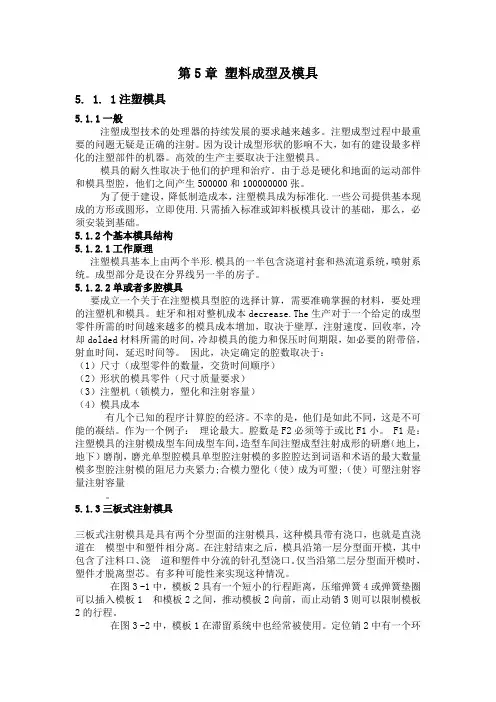
第5章塑料成型及模具5. 1. 1注塑模具5.1.1一般注塑成型技术的处理器的持续发展的要求越来越多。
注塑成型过程中最重要的问题无疑是正确的注射。
因为设计成型形状的影响不大,如有的建设最多样化的注塑部件的机器。
高效的生产主要取决于注塑模具。
模具的耐久性取决于他们的护理和治疗。
由于总是硬化和地面的运动部件和模具型腔,他们之间产生500000和100000000张。
为了便于建设,降低制造成本,注塑模具成为标准化.一些公司提供基本现成的方形或圆形,立即使用.只需插入标准或卸料板模具设计的基础,那么,必须安装到基础。
5.1.2个基本模具结构5.1.2.1工作原理注塑模具基本上由两个半形.模具的一半包含浇道衬套和热流道系统,喷射系统。
成型部分是设在分界线另一半的房子。
5.1.2.2单或者多腔模具要成立一个关于在注塑模具型腔的选择计算,需要准确掌握的材料,要处理的注塑机和模具。
蛀牙和相对整机成本decrease.The生产对于一个给定的成型零件所需的时间越来越多的模具成本增加,取决于壁厚,注射速度,回收率,冷却dolded材料所需的时间,冷却模具的能力和保压时间期限,如必要的附带倍,射血时间,延迟时间等。
因此,决定确定的腔数取决于:(1)尺寸(成型零件的数量,交货时间顺序)(2)形状的模具零件(尺寸质量要求)(3)注塑机(锁模力,塑化和注射容量)(4)模具成本有几个已知的程序计算腔的经济。
不幸的是,他们是如此不同,这是不可能的凝结。
作为一个例子:理论最大。
腔数是F2必须等于或比F1小。
F1是:注塑模具的注射模成型车间成型车间,造型车间注塑成型注射成形的研磨(地上,地下)磨削,磨光单型腔模具单型腔注射模的多腔腔达到词语和术语的最大数量模多型腔注射模的阻尼力夹紧力;合模力塑化(使)成为可塑;(使)可塑注射容量注射容量。
5.1.3三板式注射模具三板式注射模具是具有两个分型面的注射模具,这种模具带有浇口,也就是直浇道在模型中和塑件相分离。
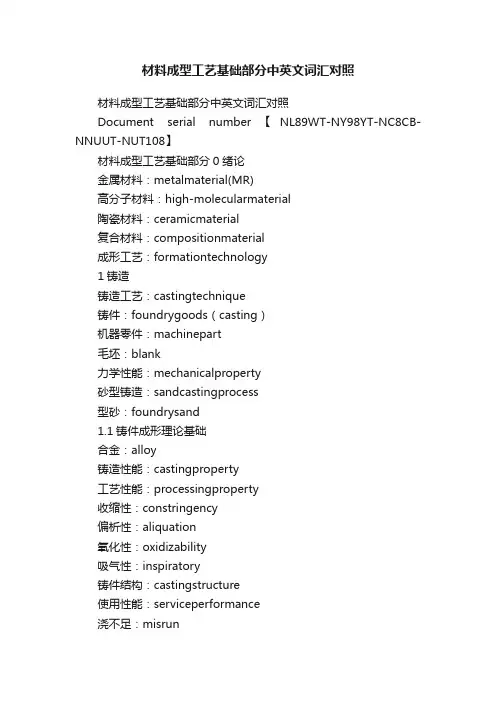
材料成型工艺基础部分中英文词汇对照材料成型工艺基础部分中英文词汇对照Document serial number【NL89WT-NY98YT-NC8CB-NNUUT-NUT108】材料成型工艺基础部分0绪论金属材料:metalmaterial(MR)高分子材料:high-molecularmaterial陶瓷材料:ceramicmaterial复合材料:compositionmaterial成形工艺:formationtechnology1铸造铸造工艺:castingtechnique铸件:foundrygoods(casting)机器零件:machinepart毛坯:blank力学性能:mechanicalproperty砂型铸造:sandcastingprocess型砂:foundrysand1.1铸件成形理论基础合金:alloy铸造性能:castingproperty工艺性能:processingproperty收缩性:constringency偏析性:aliquation氧化性:oxidizability吸气性:inspiratory铸件结构:castingstructure使用性能:serviceperformance浇不足:misrun冷隔:coldshut夹渣:cinderinclusion粘砂:sandfusion缺陷:flaw,defect,falling流动性:flowingpower铸型:cast(foundrymold)蓄热系数:thermalstoragecapacity浇注:pouring凝固:freezing收缩性:constringency逐层凝固:layer-by-layerfreezing糊状凝固:mushyfreezing结晶:crystal缩孔:shrinkagevoid缩松:shrinkageporosity顺序凝固:progressivesolidification冷铁:ironchill补缩:feeding等温线法:constanttemperaturelinemethod内接圆法:inscribedcirclemethod 铸造应力:castingstress 变形:deforming裂纹:crack机械应力:mechanicalstress热应力:heatstress相变应力:transformationstress 气孔:blowhole铸铁:ingot铸钢:caststeel非铁合金:nonferrousalloy灰铸铁:graycast-iorn孕育处理:inoculation球墨铸铁:spheroidal球化处理:sheroidisation可锻铸铁:ductilecastiron石墨:graphite蠕墨铸铁:vermicularcastiron热处理:heatprocessing铝合金:Al-alloy熔炼:fusionmetallurgy铜合金:copperalloy氢脆:hydrogenbrittleness1.2铸造方法(castingmethod)手工造型:handmoulding机器造型:machinemoulding金属型:metalmoldcasting金属模:permanentmould压力铸造:presscasting熔模铸造:investmentmoulding蜡膜:cere离心铸造:centrifugalcasting低压铸造:castingunderlowpressure 差压铸造:counter-pressurecasting 陶瓷型铸造:shawprocess1.3铸造工艺设计浇注位置:pouringposition分型面:mouldjoint活块:loosepiece起模:patterdrawing型芯:core型芯撑:chaplet工艺参数:processingparameter下芯:coresetting合型:mouldassembly冒口:castinghead尺寸公差:dimensionaltolerance 尺寸公差带:tolerancezone 机械加工余量:machiningallowance 铸孔:corehole非标准:nonstandardlabel收缩率:rateofcontraction线收缩:linearcontraction体收缩:volumecontraction起模斜度:patterndraft铸造圆角:curvingofcastings芯头:coreregister芯头间隙:clearance芯座:coreprintseat分型线:jointline分模线:diepartingline1.4铸造结构工艺性加强筋:ribreinforcement撒砂:stuccoing内腔:entocoele2金属塑性加工塑性加工:plasticworking塑性:plasticproperty锻造:forgework冲压:punching轧制:rolling拉拔:drawing挤压:extruding细化晶粒:grainrefinement热锻:hit-forging温锻:warmforging2.1金属塑性加工理论基础塑性变形:plasticyield加工硬化:work-hardening韧性:ductility回复温度:returntemperature再结晶:recrystallize再结晶退火:fullannealing冷变形:colddeformation热变性:heatdenaturation锻造比:forgingratio镦粗:upset拔长:pullout纤维组织:fibroustissue锻造性能:forgingproperty可锻性:forgeability变形抗力:resistanceofdeformation化学成分:chemicalconstitution热脆性:hotbrittleness冷脆性:cold-shortness变形速度:deformationvelocity应力状态:stresscondition变形温度:deformationtemperature过热:overheating过烧:burning脱碳:carbonelimination始锻温度:initiationforgingtemperature 终锻温度:finalforgingtemperature2.2金属塑性加工方法自由锻:flat-diehammer冲孔:jetting弯曲:bend弯曲半径:bendingradius切割:cut扭转:twistrotation错移:offsetting锻接:percussion基本工序:basicprocess辅助工序:auxiliaryprocess精整工序:finishingprocess模锻:contourforging锻模:forgingdie胎膜锻:fetalmembraneforging剪床:shearingmachine冲床:backing-outpunch冲裁:blanking弹性变形:elasticdistortion塑性变形:plasticyield剪切变形:shearingdeformation最小弯曲半径:minimumbendingradius 曲率:angularity 弯裂:rupture回弹:rebound辊轧:rollforming辊锻:rollforging斜轧:obliquerolling横轧:transverserolling辗压:tampingdrum挤压:extruding拉拔:draft2.3塑性加工工艺设计工艺规程:processspecification锻件图:forgingdrawing敷料:dressing锻件余量:forgingallowance锻件公差:forgingtolerance工夹具:clampingapparatus加热设备:firingequipment加热规范:heatingschedule冷却规范:coolingschedule后续处理:aftertreatment分模面:diepartingface冲孔连皮:punchingthewad模锻斜度:draftangle圆角半径:radiusofcorner圆饼类锻件:circumcresentcake-likeforging 长轴类锻件:longaxis-likeforging2.4锻件结构工艺性锥体:cone斜面:cant空间曲线:curveinspace粗糙度:degreeofroughness2.5冲压件结构工艺性3焊接焊接:welding铆接:riverting熔焊:fusionwelding压焊:presswelding钎焊:brazewelding3.1焊接理论基础冶金:metallurgy电弧焊:arcwelding气焊:acetylenewelding电渣焊:electro-slagwelding高能束焊:highenergywelding电子焊:electronicwelding激光焊:laserwelding等离子焊:plasmawelding电弧:electricarc阳极区:anoderegion阴极区:negativepolarity弧柱区:arcstream正接法:electrodenegativemethod 反接法:oppositionmethod脱氧剂:deoxidizingagent焊缝:weldedseam焊缝区:weldzone熔合区:fusionarea热影响区:heat-affectedzone脆性断裂:brittlefracture过热区:overheatedzone正火区:normalizedzone相变区:phasechangezone焊接应力:weldingstress收缩变形:contractiondistortion角变形:angulardeformation弯曲变形:benddeformation扭曲变形:warpingdeformation波浪变形:wavetransformation反变形法:reversibledeformationmethod刚性固定法:rigidfixingmethod预热:warming-up缓冷:slowcool焊后热处理:postweldheattreatment矫形处理:shape-righting3.2焊接方法埋弧焊:hiddenarcwelding气体保护焊:gasshieldedarcwelding氩弧焊:argonwelding熔化极氩弧焊:consumableelectrodeargonwelding 钨极氩弧焊:argontungsten-arcwelding二氧化碳气体保护焊:CO2gasshieldedarcwelding碳弧焊:carbonarcwelding碳弧气刨:carbonarcairgouging电渣焊:electro-slagwelding高能焊:highgradeenergywelding等离子弧切割:plasmaarccutting(PAC)堆焊:beadweld电阻焊:resistancewelding电焊:electricwelding缝焊:seamwelding压焊:presswelding多点凸焊:multipleprojectionwelding 对焊:weldingneck摩擦焊:frictionwelding扩散焊:diffusionwelding硬钎料:brazingalloy软钎料:softsolder3.3常用金属材料的焊接焊接性:weldability焊接方法:weldingmethod焊接材料:weldingmaterial焊条:electrode焊剂:fluxmaterial碳素钢:carbonsteel低碳钢:lowcarbonsteel中碳钢:mediumcarbonsteel高碳钢:highcarbonsteel低合金钢:leanalloysteel不锈钢:non-corrosivesteel有色金属:nonferrousmetal3.4焊接工艺设计型材:sectionalbar药皮:coating焊丝:solderingwire连续焊缝:continuousweld断续焊缝:intermittentweld应力集中:stressconcentration焊接接头:solderedjoint坡口:groove对接:abuttingjoint搭接:lapjoint角接:cornerjoint4粉末冶金(powermetallurgy)粉末冶金成品:finishedpowermetallurgicalproduct 铁氧体:ferrite硬质合金:sintered-carbide高熔点金属:high-meltingmetal陶瓷:ceramic4.1粉末冶金工艺理论基础压坯:pressedcompact扩散:diffusion烧结:agglomeration固溶:solidsolubility化合:combination4.2粉末冶金的工艺流程制备:preparation预处理:anticipation还原法:reductionmethod电解法:electrolyticmethod 雾化法:atomization粒度:grainsize松装密度:loosedensity流动性:flowingpower压缩性:compressibility筛分:screenseparation混合:compounding制粒:pelletization过烧:superburning欠烧:underburnt5金属复合成型技术自蔓延焊接:SHSwelding热等静压:HIP准热等静压:PHIP5.1液态成型技术与固态成型技术的复合高压铸造:high-pressurecasting电磁泵:magnetic-pump压射成型:injectionmolding柱塞:plungerpiston冲头:driftpin凝固法:freezingmethod挤压法:extrusionmethod转向节:knucklepivot制动器:arrestinggear5.2金属半凝固、半熔融成型技术凝固:freezing半熔融:semi-vitreous触变铸造:thixotropycasting触变锻造:thixotropyforging注射成型:injectionmolding5.3其他金属成型新技术快速凝固:flashset非晶态:amorphous溢流法:pressoversystem喷射沉积:ejectingdeposit爆炸复合法:explosioncladdingmethod 扩散焊接:diffusionwelding挤压:extruding轧制:rolldown6非金属材料成型技术6.1高分子材料成型技术高分子材料:non-metalmaterial耐腐蚀:resistantmaterial绝缘:insulation老化:ageing耐热性:heat-durability粘弹性:viscoelasticity塑料:plasticmaterial橡胶:rubber合成纤维:syntheticfibre涂料:coveringmaterial粘结剂:agglomerant粘度:viscosity热塑性塑料:thermoplasticplastics 热固性塑料:thermosettingplastic通用塑料:general-purposeplastics 工程塑料:engineeringplastic薄膜:thinfilm增强塑料:reinforcedplastics 浇注塑料:pouringplastics注射塑料:injiectionplastics 挤出塑料:extrusionplastics 吹塑塑料:blowingplastics模压塑料:diepressingplastics 聚合物:ploymersemiconductor 吸湿性:hygroscopiccargo定向作用:directionalaction 生胶:greengluestock填料:carrier丁苯橡胶:SBR顺丁橡胶:BR氯丁橡胶:CR丁腈橡胶:NBR硅橡胶:Q聚氨酯橡胶:U压延:calender硫化:sulfuration胶粘剂:adhesive胶接:gluejoint刹车片:brakeblock。
CHAPTER I MA TERIALS AND THEIR PROPERTIES1. 1 Metals and Non-metalsAmong numerous properties possessed by materials, their mechanical properties, in the majority of cases, are the most essential and therefore, they will be given much consideration in the book. All critical parts and elements, of which a high reliability is required, are made of metals, rather than of glass, plastics or stone. As has been given in Sec 1-l, metals are characterized by the metallic bond; where positive ions occupy the sites of the crystal lattice and are surrounded by electron gas .All non-metals have an ionic or a covalent bond. These types of bond are rigid and are due to electrostatic attraction of two ions of unlike charges. Because of the metallic bond, metals are capable of plastic deformation and self-strengthening upon plastic deformation. Therefore, if there is a defect in a material or if the shape of an element is such that there are stress concentrators, the stresses in these points may attain a great value and even cause cracking. But since the plasticity of the material is high, the metal is deformed plastically in that point, say, at the tip of a crack, undergoes strengthening, and the process of fracture comes to an arrest. This does not occur in non-metals. They are uncapable of plastic deformation and self-strengthening; therefore, fracture will occur as soon as the stresses at the tip of a defect exceed a definite value. These facts explain why metals are reliable structural materials and can not be excelled by non-metallic materials.Words and Terms:mechanical property 机械(力学)性能critical part and element 关键零部件covalent bond 共价键metalic bond crystal lattice 金属键晶格electrostatic attraction 静电吸引plastic deformation 塑性变形self-strengthening 自强化stress oncentrator 应力集中点the tip of a crack 裂纹尖端Questions: 1) What are the differences in properties between metals and non-metals?2) Why are metals capable of plastic deformation and self-strengthening?1. 2 Ferrous AlloysMore than 90 % by weight of the metallic materials used by human beings are ferrous alloys. This represents an immense family of engineering materials with a wide range of microstructures and related properties. The majority of engineering designs that require structural load support or power transmission involve ferrous alloys. As a practical matter, these alloys fall into two broad categories based on the carbon in the alloy composition. Steel generally contains between 0. 05 and 2.0 wt % carbon. The cast irons generally contain between 2.0 and 4.5 wt % carbon. Within the steel category,we shall distinguish whether or not a significant amount of alloying elements other than carbon is used . A composition of 5 wt % total non-carbon additions will serve as an arbitrary boundary between low alloy and high alloy steels. These alloy additions are chosen carefully because they invariably bring with them sharply increased materials costs. They are justified only by essential improvements in properties such as higher strength or improved corrosion resistance.Words and Terms:ferrous 铁的;含铁的corrosion resistance 耐腐蚀;抗蚀力arbitrary 特定的;武断的Questions:l) What is the difference in composition between steel and cast iron?2) How can you distinguish low alloy steels from high alloy steels?CHAPTER 2 HEA T TREA TMENT OF STEEL2. 1 Principle of Heat Treatment of SteelThe role of heat treatment in modern mechanical engineering cannot be overestimated. The changes in the properties of metals due to heat treatment are of extremely great significance.2. 1. 1 Temperature and TimeThe purpose of any heat treating process is to produce the desired changes in the structure of metal by heating to a specified temperature and by subsequent cooling.Therefore , the main factors acting in heat treatment are temperature and time , so that any processof heat treatment can be represented in temperature-time ( t-τ) coordinates .Heat treatment conditions are characterized by the following parameters: heating temperature t , i.e. the maximum temperature to which an alloy metal is heated; time of holding at the maxheating temperatureτh; heating rate νh and cooling rateνc.If heating (or cooling) is made at a constant rate, the temperature-time relationship will be described by a straight line with a respective angle of incline.With a varing heating (or cooling) rate , the actual rate should be attributed to the given temperature , more strictly , to an infinite change of temperature and time : that is the first derivative of temperature in time : νact = dt/dτ.Heat treatment may be a complex process , including multiple heating stages , interrupted or stepwise heating (cooling) , cooling to subzero temperatures , etc . Any process of heat treatment can be described by a diagram in temperature-time coordinates.Words and Terms:coordinates 坐标系heating rate 加热速度straight line 直线heating temperature 加热温度cooling rate 冷却速度first derivative 一阶导数Questions:1) What are the two main factors acting in heat treatment?2) How many stages may usually be inc luded in the heat treatment of steel?2. 1. 2 Formation of AusteniteThe transformation of pearlite into austenite can only take place at the equilibrium critical point on a very slow heating as follows from the Fe-C constitutional diagram. Under common conditions, the transformation is retarded and results in overheating, i.e. occurs at temperatures slightly higher than those indicated in the Fe-C diagram.When overheated above the critical point, pearlite transforms into austenite, the rate of transformation being dependent on the degree of overheating.The time of transformation at various temperatures (depending on the degree of overheating) shows that the transformation takes place faster (in a shorter time) at a higher temperature and occurs at a higher temperature on a quicker heating. For instance , on quick heating and holding at 780 ℃,the pearlite to austenite transformation is completed in 2 minutes and on holding at 740 ℃,in 8 minutes .The end of the transformation is characterized by the formation of austenite and the disappearance of pearlite (ferrite + cementite). This austenite is however inhomogeneous even in the volume of a single grain. In places earlier occupied by lamellae (or grains) of a pearlitic cementite , the content of carbon is greater than in places of ferritic lamellae . This is why the austenite just formed is inhomogeneous .In order to obtain homogeneous austenite , it is essential on heating not only to pass through the point of the end of pearlite to austenite transformation , but also to overheat the steel above that point and to allow a holding time to complete the diffusion processes in austenitc grains.The rate of homogenization of austenite appreciably depends on the original structure of the steel, in particular on the dispersion and particle shape of cementite. The transformations described occur more quickly when cementite particles are fine and, c therefore, have a large total surface area.Words and Terms : pearlite 珠光体constitutional diagrm 状态图inhomogeneous 不均匀的lamellae 层片critical point 临界温度overheat 过热grain 晶粒diffuse扩散Questions:1) Is there no diffusion process in the transformation from pearlite to austenite?2) Is it true that the higher the temperature, the faster the transformation from pearlite into austenite?3) How to obtain homogeneous austenite?CHAPTER 3 PRINCIPLES OF PLASTIC FORMING3. 1 Physical Metallurgy of Hot WorkingThe principles of the physical metallurgy of hot working are now well recognized. During the deformation process itself, e.g. a rolling pass, work hardening takes place but is balanced by the dynamic softening processes of recovery and recrystallization. These processes, which are thermally activated, lead to a flow stress that depends on strain rate and temperature as well as on strain. The structural changes taking place within the material result in an increase in dislocation density with strain until in austenitic steels and nickel- and copper-base alloys a critical strain (εc)is reached when the stored energy is sufficiently high to cause dynamic recrystallization . With further strain, dynamic recrystallization takes place repeatedly as the new recrystallized grains are themselves work-hardened to the critical level of stored energy. These dynamic structural changes leave the metal in an unstable state and provide the driving force for static recovery and static recrystallization to take place after the deformation pass. Static recrystallization may be followed by grain growth if the temperature is sufficiently high. In order to be able to apply these principles to commercial working processes, we require answers to two main questions: (a) how long does recrystallization take place after a deformation pass; and (b) what grain size is produced by recrystallization and grain growth? The answers determine the structure of the material entering the next and subsequent passes and hence influence the flow stress of the material and the working forces required. Eventually they determine the structure and properties of the hot worked products.Words and Terms : physical metallurgy 物理冶金work hardening 加工硬化static recovery静态回复thermally activated 热激活的hot working 热加工dynamic softening 动态软化recrystallization 再结晶dislocation density 位错密度critical strain 临界应变Questions:l) When does dynamic recrystallization take place within the material work hardened?2) What do the answers to the two questions determine?3. 1. 1 Dynamic Structural ChangeDuring the deformation of austenite at hot-working temperatures and constant strain rate, the characteristic form of stress-strain curve observed is illustrated in Fig. 3. 1. These curves are for low-alloy steels, tested in torsion, but are similar to those obtained for other steels in the austenitic condition tested in torsion, tension, or compression. After initial rapid work- hardening the curves go through a maximum associated with the occurrence of dynamic recrystallization. The peak in flow stress occurs after some low fraction of recrystallization has taken place so the strain to the peak(εp) is always greater than the critical strain for dynamic recystallization (εc ) . The relationship between the two strains is complex , but it has been suggested thatεc=αεp( where αis a constant ) is a reasonable approximation for conditions of deformation of interest in hot working. however , the proposed values of αdiffer , being 0.83 , 0.86 , and 0.67 . It can be seen from Fig.3.1 that εp increases systematically with Zener-Hollomon parameter ( Z ) , independent of the particular combination of stain rate (ε)and temperature ( T / K ) in the relationship : Z=εexp Q def/RTWhere the activation energy Q def for this alloy steel is 314 kJ/mol. A similar value of 312kJ/mol is appropriate for a range of C-Mn steels but lower values of 270 and 286 kJ/mol have also been observed.Asεc marks a change in microstructure from one of somewhat poorly developed subgrains , produced by the action of work hardening and dynamic recovery,to one which also contains recrystallization nuclei , it is also a critical strain in terms of the static structural changes that take place after deformation . The dependence of εp,and hence of εc,on Z is shown for the low-alloy steel and a number of C-Mn steels in Fig. 3.2. It can be seen that, indicated by the Fig.3.2 ,εp generally increases with increasing Z although the curve for the data of Sakui et al. passes through a minimum at Z = 3 x 10s-1,( corrected to Q def = 312 kcal / mol ) . The curves for the data of Nakamura and Ueki, Cook, Rossard and Blain, and Hughes, and also the data of Suzuki et al. for a number of C-Mn steels were obtained from tests on material reheated to the same temperature as the testing temperature.These all show a trend for higher values of εp at higher testing temperatures.In contrast, the curves for the data of Le Bon et al. , Barraclough , and Morrision refer to tests carried out at lower temperature than the reheating temperature and these show no effect of test temperature 0n εp.In the former group of results, higher reheating/test temperatures will give larger initial grain sizes. As shown by Sah et al., Sakui et al., and Roberts et al. , increase in grain size ( d0)leads to an increase inεp and their data indicate a relationship of the form εp∝d0^ 1/2 Words and TermsStress-strain curve 应力应变曲线torsion 扭转;转矩activation energy 激活能initial grain size 原始晶粒尺寸Questions:l ) What doεc andεp mark ?2 ) What is the relationship between εc andεp ?3. 1. 2 Static Recrystallization RateAfter deformation, softening by static recovery and recrystallization take place with time at rates which depend on the prior deformation conditions and the holding temperature. These processes may be followed by studying the changes in yield or flow stress during a second deformation given after different holding times to obtain a restoration index, or recrystallization may be measured directly by metallographic examination of quenched specimens. An example of the form of recrystallization curves obtained by the latter method for low-alloy steel is shown inFig 3.3. The curves generally follow an A vrami equation of the formwhere X v is the fraction recrystallized in time t ; t F is the time for some specified fraction of recrystallization ( say 0.5 ) ; k is a constant ; and C=-In ( 1-F ) . For the Curves shown k = 2 , which is consistent with the value observed for other steels deformed to strains <εc.With this relationship t0.05=0 . 27t0.5 and t0.95 = 2.08 t0.5 , i.e. recrystallization proceeds over about one order of magnitude in time.The dependence on strain of the characteristic time t0.5, measured by either metallographic or restoration method, is shown for several steels in Fig. 3.4. All the curves show a steep dependence on strain for strains up to ~0. 8εp,which fits a relationship t0.5∝ε-m , where the mean value of m = 4 . This value is also given by observations on ferritic metals. The lower limit of strain to which this relationship is applicable is uncertain as the critical strain for static recrystallization has not received systematic study. The data of Norrison indicate that it is < 0.05 for low-carbon steel at 950℃whereas the observations of Djaic and Jonas indicate a value of > 0.055 for high-carbon steel at 780 ℃.It is clear whether this difference arises from thedifference in temperature or composition as the simple dependence on Z suggested by the broken line in Fig. 3.2 may be unrealistic. This deserves further study as low strains my be applied in the final passes of plate rolling and , as shown previously , these could have significant effects on the final grain size if they exceed the critical strain for static recrystallization.In the strain range of steep dependence of t0.5 on ε,Morrison observed that there was no effect of strain rate over the two orders of magnitude studied . This is somewhat surprising as interesting strain rate (or Z) increases the flow stress at any particular strain. Increasing flow stress would be expected to increase the random dislocation density and decrease the subgrain size and hence increase the stored energy.The subgrain boundaries provide the largest contribution to the stored energy and as their misorientation increases with strain, the driving force for recrystallization will increase. However, this increase would be expected to be about linear with strain so the much greater dependence of t0.5on strain must also arise from an increase in density of nucleation sites and in nucleation rate. The lack of influence of strain rate may thus reflect compensating effects on stored energy and substructure development at any strain. This contrasts with the strain rate effect observed for stainless steel.The observations of Djaic and Jonas indicate that an abrupt change takes place from strain dependence to independence at a strain ~0.8εp,as illustrated in Fig . 3. 4. This corresponds reasonably with the strain expected forεc and arises because preexisting recrystallization nuclei are always present in the deformed structure at strains greater thanεc.Static recrystallization under these conditions has been referred to as ‟metadynamic‟ to distinguish it from the 'classical ' recrystallization after lower strains when the nuclei must be formed after deformation . The restoration measurements indicate that the recrystallization kinetics may have a complex form after strains betweenεc and the onset of steady state , and direct metallographic observations of static recrystallization after stains well into steady state show that the exponent k in the A vrami equation drops to a value of ~1 . This means that t0.05 = 0.074 t0.5 and t0.95 = 4.33 t0..5, i. e. static recrystallization proceeds over about two orders of magnitude in time after strains which give dynamically recrystallized structures during deformation 。
材料成型及控制工程专业英语翻译(部分)第一篇:材料成型及控制工程专业英语翻译(部分)第3章的原则塑料成型3。
1热加工物理冶金现在公认的热加工物理冶金的原则。
在变形过程本身,例如一个滚动的传递,加工硬化发生,但回收和再结晶过程的动态软化平衡。
这些过程,这是热激活,导致一个流动应力,应变率和温度,以及依赖于应变。
结构性变化的应变与位错密度增加放置在一个临界应变(εc)奥氏体钢,镍和铜合金材料的结果,直到达到储存的能量足够高时会导致动态再结晶。
随着进一步的压力,动态再结晶发生多次新的再结晶晶粒本身加工硬化储存能量的临界水平。
这些动态的结构变化离开金属处于不稳定的状态,并提供静态恢复和静态再结晶变形传递后的推动力。
可遵循静态再结晶晶粒的生长,如果温度足够高。
为了能够把这些原则运用到商业工作流程,我们需要回答两个主要问题:(一)多久再结晶后变形传递到位;及(b)什么晶粒尺寸再结晶和晶粒生长产生?这些问题的答案决定进入未来和后续传递物质的结构,从而影响材料的流动应力和所需的工作力量。
最后,他们确定的热作产品的结构和性质。
3。
1。
1动态的结构变化在变形奥氏体在热加工温度和恒应变速率,观察应力应变曲线的特点形式如图所示。
3。
1。
这些曲线是低合金钢,扭转测试,但类似的其它钢得到扭转,紧张,或压缩测试奥氏体条件。
经过初期快速加工硬化曲线通过动态再结晶的发生相关的一个最大。
在流动应力峰值出现一些低分数的再结晶后已经发生这样的峰值应变(εp)总是大于临界应变动态recystallization(εc)。
两个菌株之间的关系是复杂的,但它已建议thatεc=αεp(其中α是一个常数)是一个合理的近似变形热工权益的条件下。
然而,α的建议值不同,0.83,0.86,和0.67。
它从图3.1可以看出,εp增加系统与ZenerMn钢,但较低的值的270和286 kJ / mol的范围,也被观察到。
Asεc标志着亚颗粒有点不发达,加工硬化和动态恢复行动,其中也包含了再结晶核的变化,在微观结构,它也是一个静态后发生的结构性变化的临界应变变形。
2009 © Hisuntech Corp.材料成型及控制工程专业英语▪Translation Skill —Semantic Extension▪(翻译技巧——句子成分转换)➢谓语、表语、宾语、状语转译成主语;➢主语、定语、表语、状语转译成谓语;➢主语、状语、宾语转译成定语;➢定语、谓语、主语转译成状语;➢主语、状语、谓语转译成宾语;➢主语、宾语转译成表语。
▪句子成分转换是指词类不变而成分改变的译法。
通过改变原文中某些句子成分,以达到译文逻辑正确、通顺流畅、重点突出等目的。
谓语、表语、宾语、状语转译成主语●Gases differ from liquids in that the former have greater compressibility than the latter.●译:气体和固体的区别,在于前者比后者有更大的压缩性。
(谓语转译成主语)●Rubber is a better dielectric but a poorer insulator than air.●译:橡胶的介电性比空气好,但绝缘性比空气差。
(表语转译成主语)●Water has a density of 62.4 pounds per cubic foot.●译:水的密度是每立方英尺62.4磅。
(宾语转译成主语)谓语、表语、宾语、状语转译成主语●Aluminum is very light in weight, being only one third as heavy as iron.●译:铝的重量很轻,只有铁的1/3.(状语转译成主语)●The same signs and symbols of mathematics are used throughout the world..●译:全世界都使用同样的数学记号和符号。
(状语转译成主语)主语、定语、表语、状语转译成谓语●The prevention of many types of occupational diseases isdistinctly within the realm of possibility.●译:许多职业病显然可以预防。
材料成型级控制工程专业英语阅读1.2.1 Plain Carbon Steel 普通碳钢Hot-rolled steel delivered (供给)by steelmaking works as rolled sections(bars, beams,sheets.tubes,etc) is the most wildly used material for manufacture of various machines,machine tools, building structures,consumer goods,etc.Delivered steel should have the properties as specified by State Standards (国家标准).钢铁制造车间供给的热轧钢主要为棒材、柱材、板材、管材等,热轧钢是制造各种机械、机器工具、建筑结构和消费品中应用最广泛的材料。
所供给的钢应具有国家标准规定的各种性能。
In the RSSU.Plain carbon steels are classified into three groups:A, B and C,depending on their application.在RSSU中,普通碳钢根据其用途分为A、B、C三类。
A: If a steel is to be used for making products without hot working (welding, Forging.Etc.). Its structure and properties in the final product will be the same as delivered from the rolling mill.In that case the user requests for a steel of warranted(保证)mechanical properties,while the chemical composition is not guaranteed(保证、担保).A:如果钢在制造产品的过程中没有进行热加工(焊接、锻造等),则最终产品的组织和性能将与轧厂提供的相同。
2009 © Hisuntech Corp.材料成型及控制工程专业英语▪Translation Skill —Semantic Extension▪(翻译技巧——句子成分转换)谓语、表语、宾语、状语转译成主语; 主语、定语、表语、状语转译成谓语; 主语、状语、宾语转译成定语;定语、谓语、主语转译成状语;主语、状语、谓语转译成宾语;主语、宾语转译成表语。
▪句子成分转换是指词类不变而成分改变的译法。
通过改变原文中某些句子成分,以达到译文逻辑正确、通顺流畅、重点突出等目的。
谓语、表语、宾语、状语转译成主语●Gases differ from liquids in that the former have greater compressibility than the latter.●译:气体和固体的区别,在于前者比后者有更大的压缩性。
(谓语转译成主语)●Rubber is a better dielectric but a poorer insulator than air.●译:橡胶的介电性比空气好,但绝缘性比空气差。
(表语转译成主语)●Water has a density of 62.4 pounds per cubic foot.●译:水的密度是每立方英尺62.4磅。
(宾语转译成主语)谓语、表语、宾语、状语转译成主语●Aluminum is very light in weight, being only one third as heavy as iron.●译:铝的重量很轻,只有铁的1/3.(状语转译成主语)●The same signs and symbols of mathematics are used throughout the world..●译:全世界都使用同样的数学记号和符号。
(状语转译成主语)主语、定语、表语、状语转译成谓语●The prevention of many types of occupational diseases isdistinctly within the realm of possibility.●译:许多职业病显然可以预防。
(主语转译成谓语)●A semiconductor has a poor conductivity at room temperature, but it may become a good conductor at high temperature.●译:在室温下,半导体导电率差,但在高温下,它可能成为良导体。
(定语转译成谓语)●The wide applications of computers affect tremendously the development of science and technology.●译:计算机的广泛应用,对科学技术的影响极大。
(状语转译成谓语)主语、定语、表语、状语转译成谓语●Also present in solids are numbers of free electrons.●译:固体中也存在着大量的自由电子。
(表语转译成谓语)主语、状语、宾语转译成定语●CMOS chips in the computer work a thousand times more rapidly than nerve cells in the human brain.●译:电脑芯片的工作比人类大脑中的神经细胞要快1000倍。
(主语转译成定语)●In Britain the first stand-by gas-turbine electricity generator was in operation in Manchester in 1952.●译:英国的第一台辅助燃气发电机于1952年在曼彻斯特开始运转。
(状语转译成定语)●By 1914 Einstein had gained world fame.●译:1914年爱因斯坦已成了著名的科学家。
(宾语转译成定语)定语、谓语、主语转译成状语●After more experiments, Galileo succeeded in making a muchbetter telescope.译:又做了一些实验之后,伽利略成功地制造了一架好得多的望远镜。
(谓语转译成状语)●The result of its revolutionary design is that the engine is muchsmaller, works more smoothly, and has fewer moving parts.●译:由于他在设计上的革新,发动机变得小多了,工作得更平稳了,活动部件也少了。
(主语转译成状语)定语、谓语、主语转译成状语●It was an amazing piece of scientific clairvoyance, comparableperhaps to Charles Babbage’s anticipation of the principle of the computer.●译:这个理论在科学上充满了元件卓识,也许可以跟巴贝奇的计算机原理相提并论。
(定语转译成状语)主语、状语、谓语转译成宾语●The mechanical energy can be changed back into electrical energy by means of a generator.●译:利用发电机可以把机械能重新转变成电能。
(主语转译成宾语)●Television has been successfully sent by laser, too.●译:用激光发射电视也获得了成功。
(状语转译成宾语)●The sun affects tremendously both the mind and body of a man.●译:太阳对人的身体和精神都有极大的影响。
(谓语转译成宾语)主语、宾语转译成表语●A great contribution of Edison was the carbon microphone.●译:炭精传声器是爱迪生的一大贡献。
(主语转译成表语)●The production had considerable difficulty getting patent protection if it had no patent right.●译:如果产品没有专利权,要获得专利保护是相当困难的。
(宾语转译成表语)由此看来,句子成分的转译显得变化万千,异彩纷呈,难于穷究,几乎所有的句子成分都可以互相转译。
进行成分转译的目的是为了使译文通顺,合乎汉语习惯和更好地跟上下文响应。
11.1Various Casting Process☐sand mold 砂型☐plastic-bonded shell mold 塑性粘结壳型☐die-casting metal mold 压铸用金属型☐plaster mold 石膏型☐investment 熔模铸造☐shrinkage 收缩☐flask 砂箱☐core 型芯☐dry sand molds 干砂铸型11.1Various Casting Process☐green sand mold 湿砂铸型☐thermosetting resin 热固树胶(脂)☐centrifugal casting 离心铸造☐low-melting alloys 低熔点合金☐silica 硅石,硅土,无水硅酸☐ethyl silicate 硅酸乙酯☐tilting furnace 可倾式铁炉砂型和芯是用型砂和芯砂制造的。
型(芯)砂是由原砂、粘结剂、水和附加物按一定比例混合制成。
用一种遇热硬化的型砂(酚醛树脂覆膜砂)覆盖在加热到180~280℃的金属模板上,使其硬化为薄壳(薄壳厚度一般为6~12毫米),再加温固化薄壳,使达到足够的强度和刚度,因此将上下两片型壳用夹具卡紧或用树脂粘牢后,不用砂箱即可构成铸型,浇注铸件金属模板的加热温度一般为300℃左右,使用的型砂为树脂砂,即以酚醛树脂为粘结剂的树脂砂。
同样也可用上述方法将型芯制成薄壳芯制造薄壳铸型常用翻斗法。
制造薄壳芯常用吹制法。
▪砂型铸造视频CHAPTER 11 CASTING☐The principal casting processes are classified accordingto the kind of mold used. These are sand molds, plastic-bonded shell molds, permanent and semipermanent metal molds, die-casting metal molds, plaster molds, andinvestment molds.☐主要的铸造工艺是根据使用的模具种类来分类的。
模具类型是砂型,塑性粘结壳型,永久和半永久性的金属型,压铸金属模型,石膏模具,熔模铸型。
▪classify 分类;分等▪permanent永久的☐The first step in the production of a sand casting is tomake a metal or wooden pattern.The pattern is a replicaof the part being made but has slightly larger dimensions to allow for shrinkage during solidification and cooling of the casting.☐砂型铸造生产的第一步是制造一副金属或木质模型。
该模型是所铸零件的复制品,但是考虑到铸件凝固和冷却过程中产生收缩,这个模型尺寸有些许放大。
▪replica 复制品,复制物▪shrinkage收缩☐The pattern is often made in two or more parts so it canbe removed easily from the mold. To make the mold, sand is rammed or packed around the pattern, the sand beingheld in place by a boxlike container known as a flask.☐木模往往被做成两部分或更多部分,所以他们能够很容易地从模具中(这个模具其实就是沙子制成的)取出。
为做出这个模具,砂子在木模周围要压紧、夯实,砂子被放在称为铸型砂箱的盒子形状的容器内。